Andrew Wireless System NCM843 Repeater for Cellular Networks User Manual Additional information on SM2009
Andrew Wireless System Repeater for Cellular Networks Additional information on SM2009
User Manual
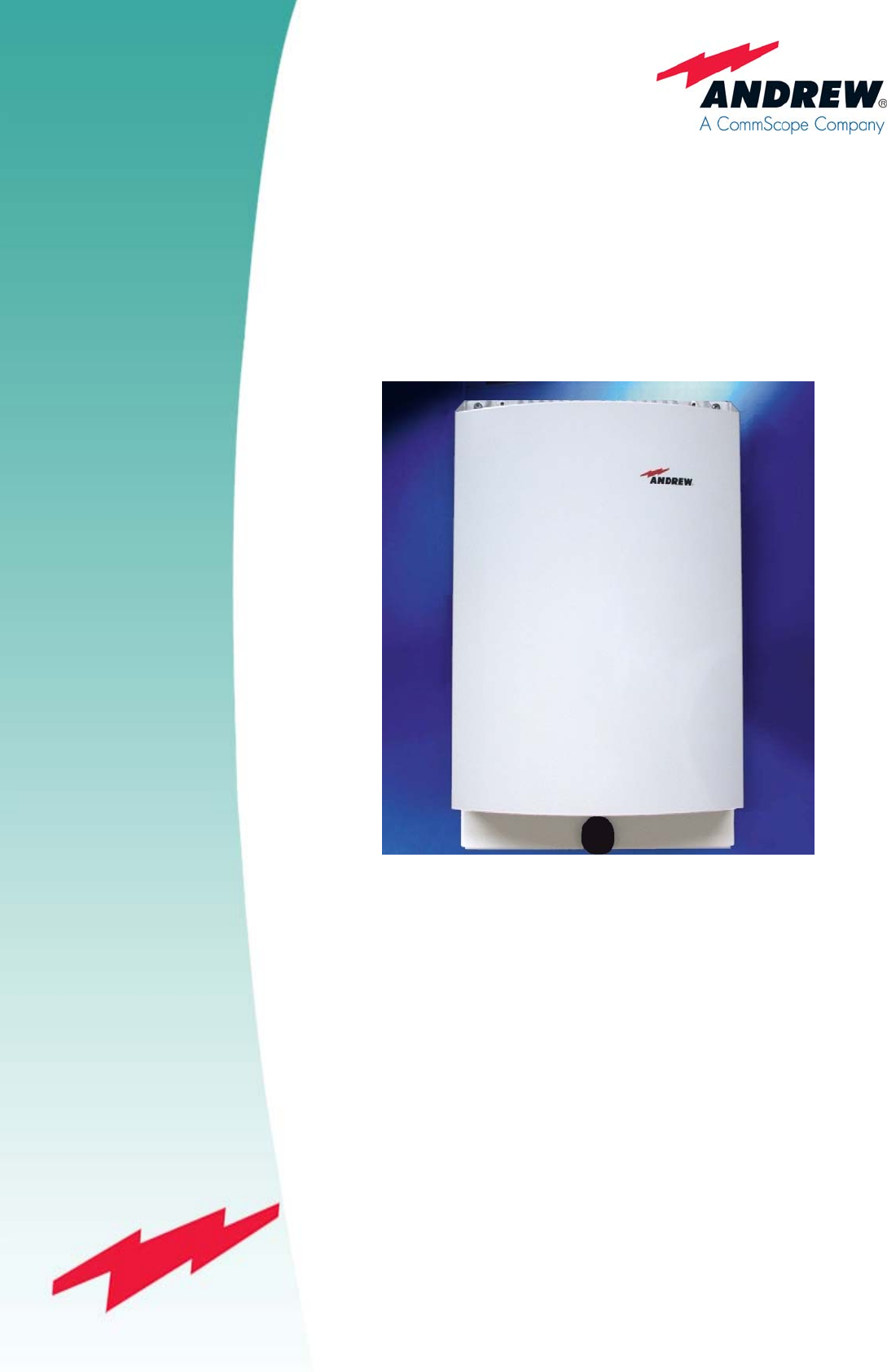
Repeaters
Node M and Node C
Network Elements
User's Manual
M0121A4A

User’s Manual for Node M and Node C
Network Elements
Page 2 M0121A4A.doc
© Copyright 2010 CommScope, Inc.
All rights reserved.
Andrew Solutions is a trademark of CommScope, Inc.
All information contained in this manual has been revised thoroughly. Yet Andrew
Solutions accepts no liability for any omissions or faults.
Andrew Solutions reserves the right to change all hard- and software characteristics
without notice.
Names of products mentioned herein are used for identification purposes only and
may be trademarks and / or registered trademarks of their respective companies.
No parts of this publication may be reproduced, stored in a retrieval system,
transmitted in any form or by any means, electronical, mechanical photocopying,
recording or otherwise, without prior written permission of the publisher.
Andrew Wireless Systems GmbH, 05-February -2010

Page 3
TABLE OF CONTENTS
1. GENERAL 7
1.1. USED ABBREVIATIONS 7
1.2. HEALTH AND SAFETY WARNINGS 9
1.3. ABOUT ANDREW SOLUTIONS 11
1.4. INTERNATIONAL CONTACT ADDRESSES FOR WIG CUSTOMER SUPPORT 12
2. INTRODUCTION 15
2.1. PURPOSE 15
2.2. THE NODE M AND NODE C (NODE M/C) NETWORK ELEMENT 15
2.3. QUICK START CHECKLIST 16
3. CONNECTION SETUP 19
3.1. SETTING UP A LOCAL / LAN CONNECTION FROM LAPTOP / PC 19
3.2. SETTING UP NODE M/C REPEATER TO RUN AS A LAN ELEMENT 20
3.2.1. Prerequisites 20
3.2.2. Procedure 20
3.3. SETTING UP A REMOTE CONNECTION 21
4. INSTALLATION 23
4.1. MECHANICAL INSTALLATION 23
4.1.1. General 23
4.1.2. Wall Mounting Procedure 24
4.1.3. Pole Mounting Procedure 26
4.2. ELECTRICAL INSTALLATION 29
4.2.1. General 29
4.2.2. Grounding 30
4.2.3. Power Connection 31
4.2.4. Connection of the Antenna Cables 33
4.2.5. Opening the Cabinet - Mains Power Switch 34

User’s Manual for Node M and Node C
Network Elements
Page 4 M0121A4A.doc
5. FUNCTIONAL DESCRIPTION 37
5.1. DIGITAL ARCHITECTURE 37
5.2. FEATURES 39
5.2.1. Filters Node M 39
5.2.2. Filters Node C 39
5.2.3. Digital ICE (Digital Interference Cancellation Equipment) 40
5.2.4. VSWR (Voltage Standing Wave Ratio) 40
5.2.5. RSSI (Receive Signal Strength Indication) 41
5.2.6. Alarm Forwarding 41
5.2.7. Downlink Final Amplifier 42
5.2.8. Power Supply Unit 44
5.2.9. Modems 45
5.2.10. Digital Channel Module (DCM) 48
5.2.11. External Alarm Controller - EAC-Board 49
5.2.12. Battery Pack - Battery On/Off 55
5.2.13. UL and DL Duplexer 57
6. MAINTENANCE AND REPLACEMENT 59
7. ILLUSTRATIONS 59
7.1. CABINET DRAWING 59
7.2. LAYOUT OF THE NODE M/C 843 60
8. INDEX 61

Page 5
FIGURES AND TABLES
figure 3-1 Ethernet connector RJ45 19
figure 3-2 Pin connection 20
figure 3-3 Cable gland position 20
figure 4-1 Positions of drilling holes 24
figure 4-2 Wall mounting procedure 25
figure 4-3 Pole mounted units 26
figure 4-4 Back-to-back pole mounting 27
figure 4-5 Grounding bolt 30
figure 4-6 Power supply plug 31
figure 4-7 Mains connector of a Node M, exemplary 31
figure 4-8 Mains connector and antenna connections of a Node C, exemplary 31
figure 4-9 Front view of antenna connections from Node C, exemplary 33
figure 4-10 Front and top cover screws 34
figure 4-11 Position of mains power switch 35
figure 5-1 Configuration of a network element 37
figure 5-2 RF path of a Node C 843, exemplary 38
figure 5-3 Node M/C x37 MCPA DL final amplifier 42
figure 5-4 Node M 2143 and Node M 1943 MCPA DL final amplifier 42
figure 5-5 Node M/C 843 DL final amplifier 43
figure 5-6 Power supply, Node M/C x37 44
figure 5-7 Power supply, Node M/C x43 44
figure 5-8 Modem MC35 45
figure 5-9 Redwing modem (CDMA) 45
figure 5-10 Modem AnyDATA iPORT EMIII Dual / EM IV Dual 46
figure 5-11 Modem Raven XT 46
figure 5-12 Modem MTCBA-C-N9 46
figure 5-13 Cable from modem to donor duplexer 47
figure 5-14 Cable from modem to external modem antenna port; Node M 47
figure 5-15 Digital channel module, DL part 48
figure 5-16 Digital channel module, UL part 48
figure 5-17 EAC-board, installed 49
figure 5-18 Function of LEDs on the EAC-board 51
figure 5-19 Pin assignment 52

User’s Manual for Node M and Node C
Network Elements
Page 6 M0121A4A.doc
figure 5-20 External alarm clamps, installed 52
figure 5-21 Configuration of external alarm clamps 53
figure 5-22 External cable glands 53
figure 5-23 Summary alarm relay 54
figure 5-24 Relay contacts, alarm condition 54
figure 5-25 Battery pack, exemplary 55
figure 5-26 Battery pack installed and its connection to DCM 55
figure 5-27 Position of the battery disconnect button on the EAC-board 56
figure 5-28 Duplexer, UL IN 57
figure 5-29 Duplexer, DL IN 57
figure 5-30 Duplexers installed 57
figure 5-31 Duplexers installed, ceramic duplexer DL IN 58
figure 7-1 Cabinet of a Node M, respective Node C, exemplary 59
figure 7-2 Layout of the Node M/C 843, exemplary 60
table 1-1 List of international contact addresses....................................................... 13
table 4-1 Required length of thread-bolts ................................................................. 26
table 4-2 Components of pole mounting kit .............................................................. 27
table 4-3 Pin assignment of mains connector........................................................... 32
table 5-1 Pin assignment of relay contacts ............................................................... 54

1 General
Page 7
1. GENERAL
1.1. USED ABBREVIATIONS
A/D Analogue to Digital Converter
AGC Automatic Gain Control
ALC Automatic Level Control
ARFCN Absolute Radio Frequency Channel Number
BCCH Broadcast Control Channel
BTS Base Transceiver Station
CDMA Code Division Multiple Access
D/A Digital to Analogue Converter
DAS Distributed Antenna System
DCM Digital Channel Module
DHCP Dynamic Host Configuration Protocol
D-ICE Digital Interference Cancellation Equipment
DL Downlink
DSP Digital Signal Processor
EAC External Alarm Controller
EDGE Enhanced Data Rates for GSM Evolution
ESD Electrostatic Discharge
ETS European Telecommunication Standard
ETSI European Telecommunication Standards Institute
FCC Federal Communications Commission
FRU Field Replaceable Unit
GPRS General Packet Radio Service
GSM Global System for Mobile Communication
HID Hardware Inventory Data
HSN Hopping Sequence Number
I2C Bus Inter Integrated Circuit Bus (Philips)
ICE Interference Cancellation Equipment
ID No Identification Number
LAN Local Area Network
LED Light Emitting Diode
LMT Local Maintenance Terminal
LNA Low Noise Amplifier
LO Local Oscillator
MAIO Mobile Allocation Index Offset
MCPA Multi Carrier Power Amplifier
Ncm Newton centimeter
NSB Network Supervision Box
OFDM Orthogonal Frequency Division Multiplex
OMC Operation and Maintenance Centre
PA Power Amplifier
PAMR Public Access Mobile Radio
PPP Point-to-Point Protocol
PSTN Public Switched Telephone Network
RF Radio Frequency

User’s Manual for Node M and Node C
Network Elements
Page 8 M0121A4A.doc
RLP Radio Link Protocol
RSCP Received Signal Code Power
RSSI Receive Signal Strength Indication
RTC Real Time Clock
RX Receiver
SCPA Single Carrier Power Amplifier
SDA Serial Data
SMS Short Message Service
SNMP Simple Network Management Protocol
TS Transmitter
UE User Equipment
UL Uplink
UMTS Universal Mobile Telecommunication System
UPS Uninterruptible Power Supply
UTC Universal Time Coordinate
UTRA UMTS terrestrial radio access
VCO Voltage Controlled Oscillator
VSWR Voltage Standing Wave Ratio
WCDMA Wide-band Code Division Multiple Access
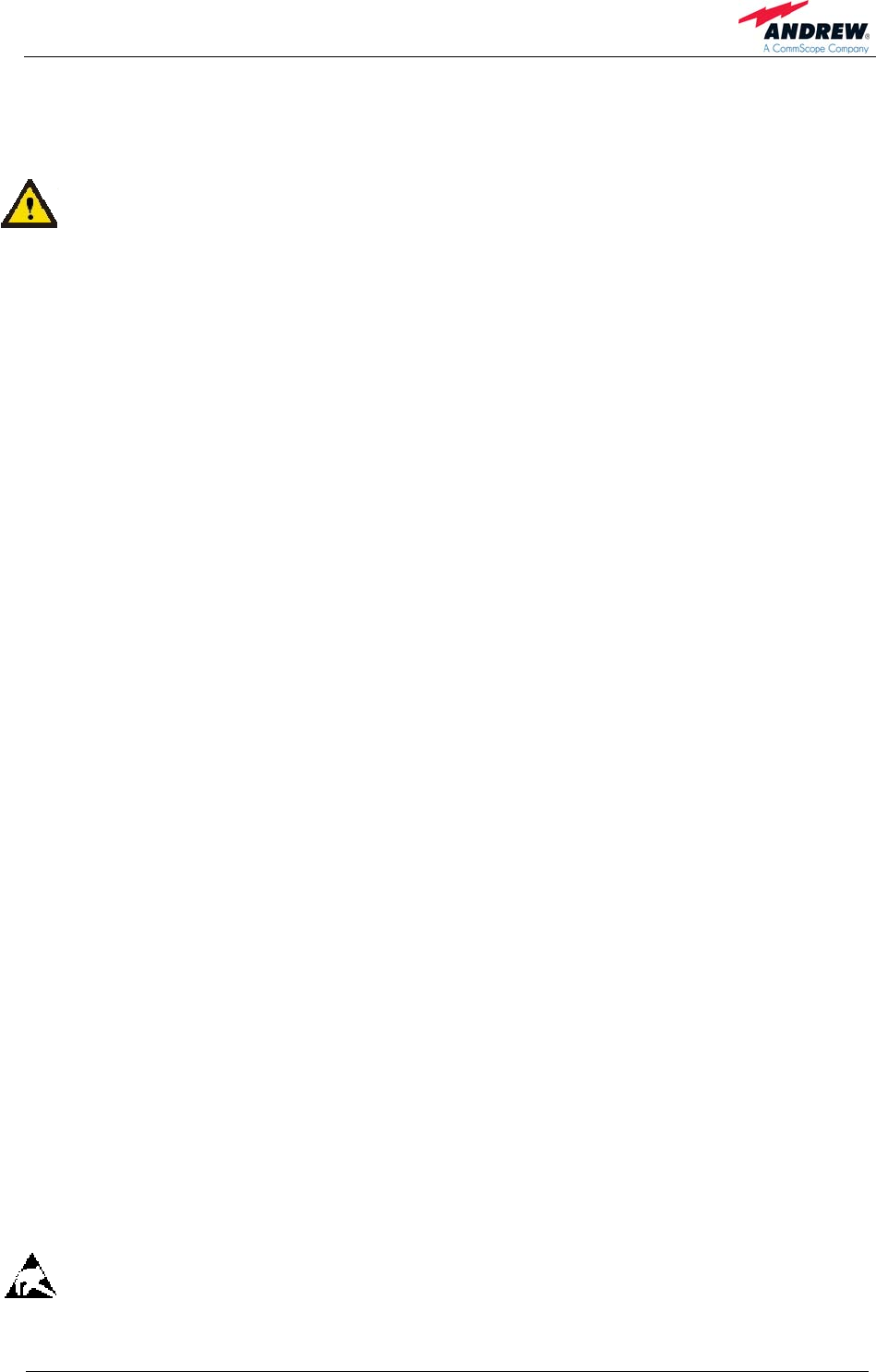
1 General
Page 9
1.2. HEALTH AND SAFETY WARNINGS
1. Only suitably qualified people are allowed to work on this unit and only after
becoming familiar with all safety notices, installation, operation and maintenance
procedures contained in this manual.
2. Read and obey all the warning labels attached to the unit. Make sure that the
warning labels are kept in a legible condition and replace any missing or
damaged labels.
3. Obey all general and regional installation and safety regulations relating to work
on high voltage installations, as well as regulations covering correct use of tools
and personal protective equipment.
4. Keep operating instructions within easy reach and make them available to all
users.
5. It is the responsibility of the network provider to implement prevention measures
to avoid health hazards which may be associated to radiation from the antenna(s)
connected to the unit.
6. IMPORTANT NOTE: To comply with FCC RF exposure compliance requirements,
the following antenna installation and device operating configurations must be
satisfied: A separation distance of at least 400 cm must be maintained between
the antenna of this device and all persons. RF exposure compliance may need to
be addressed at the time of licensing, as required by the responsible FCC
Bureau(s), including antenna co-location requirements of 1.1307(b)(3). Maximum
permissible antenna gain is 17 dBi.
7. Make sure, access is restricted to qualified personnel.
8. Only licence holders for the respective frequency range are allowed to operate
this unit.
9. Use this equipment only for the purpose specified by the manufacturer. Do not
carry out any modifications or fit any spare parts which are not sold or
recommended by the manufacturer. This could cause fires, electric shock or other
injuries.
10. Due to power dissipation, the network element may reach a very high
temperature. Do not operate this equipment on or close to flammable materials.
11. Before opening the unit, disconnect mains.
12. ESD precautions must be observed! Before commencing maintenance work, use
the available grounding system to connect ESD protection measures.

User’s Manual for Node M and Node C
Network Elements
Page 10 M0121A4A.doc
13. This unit complies with European standard EN60950.
14. Make sure the network element settings are according to the intended use (see
also product information of manufacturer) and regulatory requirements are met.
15. Although the network element is internally protected against overvoltage, it is
strongly recommended to earth the antenna cables close to the network
element’s antenna connectors for protection against atmospheric discharge.

1 General
Page 11
1.3. ABOUT ANDREW SOLUTIONS
Andrew Wireless Systems GmbH based in Buchdorf/ Germany, is a leading
manufacturer of coverage equipment for mobile radio networks, specializing in low
cost, high performance, RF and optical repeaters. Our optical distributed networks
and RF repeater systems provide coverage for every application: outdoor use, indoor
installations, tunnels, subways and many more.
Andrew Wireless Systems GmbH belongs to the Wireless Innovations Group (WIG).
Being a part of Andrew Solutions, WIG has unparalleled experience in providing RF
coverage and capacity solution for wireless networks in both indoor and outdoor
environment.
Andrew Solutions, a CommScope Company, is the foremost supplier of one-stop,
end-to-end radio frequency (RF) solutions. Our products are complete solutions for
wireless infrastructure from top-of-the-tower base station antennas to cable systems
and cabinets, RF site solutions, signal distribution, and network optimization.
Andrew Solutions has global engineering and manufacturing facilities. In addition, it
maintains field engineering offices throughout the world.
We operate a quality management system in compliance with the requirements of
ISO 9001. All equipment is manufactured using highly reliable material. In order to
ensure constant first-rate quality of the products, comprehensive quality monitoring is
conducted at all fabrication stages. Finished products leave the factory only after a
thorough final acceptance test, accompanied by a test certificate guaranteeing
optimal operation.
The declaration of conformity for the product is available upon request from the local
sales offices or from Andrew Solutions directly.
To make the utmost from this unit, we recommend you carefully read the instructions
in this manual and commission the unit only according to these instructions.
For technical assistance and support, contact the local office or Andrew Solutions
directly at one of the following addresses listed in the next chapter.

User’s Manual for Node M and Node C
Network Elements
Page 12 M0121A4A.doc
1.4. INTERNATIONAL CONTACT ADDRESSES FOR WIG CUSTOMER
SUPPORT
Wireless Innovations Group (WIG)
Americas:
Canada United States
Andrew Solutions Canada Andrew Solutions,
Andrew LLC, A CommScope Company
Mail 620 North Greenfield Parkway
Garner, NC 27529
U.S.A.
Mail 620 North Greenfield Parkway
Garner, NC 27529
U.S.A.
Phone +1-905-878-3457 (Office)
+1 416-721-5058 (Mobile) Phone +1-888-297-6433
Fax +1-905-878-3297 Fax +1-919-329-8950
E-mail Peter.Masih@andrew.com
WIsupport.us@andrew.com
E-mail WIsupport.us@andrew.com
Brazil & South America Mexico, Central America &
Caribbean region
Andrew Solutions,
A CommScope Company Andrew Solutions Mexico
Mail
Av. Com. Camilo Julio 1256
Predio B
Zonal Industrial CP 597
Sorocaba SP 18086-000
Brazil
Mail
Monte Elbruz 124-402A
Col. Palmas Polanco 11560
Mexico, D.F.
Mexico
Phone + 55-15-9104-7722 Phone + 52-55-1346-1900 (Office)
+52-1-55-5419-5260 (Mobile)
Fax + 55-15-2102-4001 Fax +52-55-1346-1901
E-mail WIsupport@andrew.com
E-mail WIsupport@andrew.com
APAC Countries:
China Australia
Andrew Solutions Hong Kong Andrew Corporation (Australia)
LLC Pty Ltd.
Mail
Room 915
Chevalier Commercial Centre
8 Wang Hoi Rd
Kowloon Bay SAR
Hong Kong
Mail
Unit 1
153 Barry Road
Campbellfield
VIC 3061
Australia
Phone +852-310-661-00 Phone +613-9300-7969
Fax +852-2751-7800 Fax +613-9357-9110
E-mail WISupport.china@andrew.com
E-mail WIsupport.australia@andrew.com

1 General
Page 13
Europe:
United Kingdom France
Andrew Solutions UK Ltd Andrew Solutions France
Mail
Unit 15, Ilex House
Mulberry Business Park
Fishponds Road
Wokingham Berkshire
RG41 2GY
England
Mail
28, Rue Fresnel
Z.A Pariwest
BP 182
78313 Coignières Cedex
France
Phone +44-1189-366-792 Phone +33 1 30 05 45 50
Fax +44-1189-366-773 Fax +33 1 34 61 13 74
E-mail WIsupport.uk@andrew.com
E-mail WIsupport@andrew.com
Germany Czech Republic
Andrew Wireless Systems GmbH Andrew Solutions Czech Republic
C-Com, spol. s r.o
Mail Industriering 10
86675 Buchdorf
Germany
Mail U Moruší 888
53006 Pardubice
Czech Republic
Phone +49-9099-69-0 Phone +420-464-6280-80
Fax +49-9099-69-930 Fax +420-464-6280-94
E-mail WIsupport@andrew.com
E-mail WIsupport@andrew.com
Austria Switzerland
Andrew Wireless Systems (Austria)
GmbH Andrew Wireless Systems AG
Mail Weglgasse 10
Wien-Schwechat 2320
Austria
Mail Tiergartenweg 1
CH-4710 Balsthal
Switzerland
Phone +43-1706-39-99-10 Phone +41-62-386-1260
Fax +43-1706-39-99-9 Fax +41-62-386-1261
E-mail WIsupport.austria@andrew.com
E-mail support.ch@andrew.com
Italy Spain & Portugal
Andrew Wireless Systems S.r.l., Faenza,
Italy Andrew Solutions España S.A.
Mail Via de Crescenzi 40
Faenza 48018
Italy
Mail C/ Salvatierra, 5 - 3a pt.
28034 Madrid
Spain
Phone +39-0546-697111 Phone +34-91-745-20 40
Fax +39-0546-682768 Fax +34-91-564-29 85
E-mail WIsupport.italia@andrew.com
E-mail WIsupport.iberia@andrew.com
table 1-1 List of international contact addresses

User’s Manual for Node M and Node C
Network Elements
Page 14 M0121A4A.doc
For your notes:

2 Introduction
Page 15
2. INTRODUCTION
2.1. PURPOSE
Wireless communication systems provide a two-way information transfer (voice and
data) between a base station and multiple mobiles within a given area.
Environmental variables such as physical structures both man-made (buildings) and
natural (mountains) attenuate signals in the transmission path, which reduce the
transport signal’s strength. This attenuation leads to a reduction in quality and data
rate and eventually prohibits the system’s use entirely. The Node M and Node C are
specifically designed to extend coverage, enhance quality, and increase air-interface
capacity.
In the downlink (DL), the Node M and Node C picks up signals coming from the base
station, filters them, amplifies them, and retransmits them to the mobile. In the uplink
(UL), it picks up signals from the mobile, filters them, amplifies them, and retransmits
them to the base station. The Node M and Node C constantly monitors the quality of
the signals passing through it, while simultaneously electronically decreasing
isolation requirements.
2.2. THE NODE M AND NODE C (NODE M/C) NETWORK ELEMENT
Node M and Node C are primary network elements, capable of enhancing up to 20
MHz of continuous spectrum. Their primary function is to increase the signal strength
between multiple mobiles and a base station in areas where basic voice or high-
speed data transmission is not available. They may be used for basic coverage,
signal reinforcement, and cell shaping, which can increase a network’s coverage
area, data rate, and capacity.
The Node M is a dedicated UMTS device, but the Node C operates with CDMA
technology. However, several enhancers operating at different frequencies and
technologies may share the same hardware (cables and antennas) via a crossband
coupler.
The Node M or Node C may be set-up locally or remotely. A circuit switch or packet
data modem may be connected to an integrated controller. This provides the network
management system with on-demand, alarm generated, or heartbeat monitoring via
the always-connected packet features. The Node M and Node C have features and
functions that may be monitored and changed by the operators via a web-based
browser remotely or locally, or via the SNMP based OMC software platform. The
graphical interfaces of Node M and Node C provide a setup menu including a setup
wizard which allows both setup and monitoring capability without any equipment
required apart from a laptop or PC.
The Node M and Node C network elements are self-diagnosing, self-adaptive, and
virtually maintenance-free.
In the following, the expression Node M/C stands for Node M and Node C.

User’s Manual for Node M and Node C
Network Elements
Page 16 M0121A4A.doc
2.3. QUICK START CHECKLIST
Read the health and safety warnings in chapter 1.2 Health and Safety Warnings.
Setting up the Node M/C is quick and easy. The following step-by-step
procedure provides a quick overview for a correct setup and optimization.
a. Required Equipment
Node M or Node C
donor antenna
coverage antenna(s) or DAS
coaxial feeder cable
connectors (RF, mains)
laptop (Win XP or Win 2000) with connection and mains cable
standard Ethernet cable (CAT5) (see chapter 3 Connection Setup)
b. Required Information
Make sure to have the following information at hand:
important on-site conditions (e.g. BTS location, mains supply, etc.)
channels to be enhanced/ amplified
pilot power to total power ratio
data of mandatory fields of Connectivity and Upload page see user's
manual for Node software.
c. Procedure
1. Install the donor (linear polarized recommended) and coverage antennas.
2. Install the feeder cable from the Node M/C to the antennas.
3. Install the Node M/C (see chapter 4.1 Mechanical Installation)
) Note: Take care to ground the unit correctly as instructed in chapter 4.2.2
Grounding.
4. Connect power and the antenna feeder cables to the Node M/C.
5. Open the Node M/C as described in chapter 4.2.5 Opening the Cabinet -
Mains Power Switch.
6. Setup the connection computer (see chapter 3 Connection Setup and software
manual).

2 Introduction
Page 17
7. Login to the unit and follow the installation wizard option for easy installation.
a. Optimize the donor antenna performance (see software manual).
b. To select the channels for enhancement, choose between the
“Measurement Assisted Channel Assignment” or “Unassisted
Channel Assignment” from the Setup Wizard page (see software
manual).
c. Enter the pilot power to total power ratio of the donor Base Station.
d. Enter the desired output power in the downlink.
e. Enter the relative uplink gain and click the “Program” button.
f. Select the “Connectivity and Upload” button, to setup the modem (if
applicable) and to enter data in the other user fields (see software
manual).
g. Select the “Technician Setup” button (see software manual), to
change additional system settings, e.g. ICE, H.R. Filter, Diversity;
the “Technician Setup” is also accessible from the home page.
8. The Node M/C setup is complete.
9. Open the “Save Configuration to Laptop” menu for record keeping purposes.
10. Unplug the computer, close the Node M/C and tighten all screws.
) Note: To do a power cycle, disconnect the battery backup by pushing the
battery disconnect button on the EAC-board; see chapter
5.2.12 Battery Pack - Battery On/Off.

User’s Manual for Node M and Node C
Network Elements
Page 18 M0121A4A.doc
For your notes:
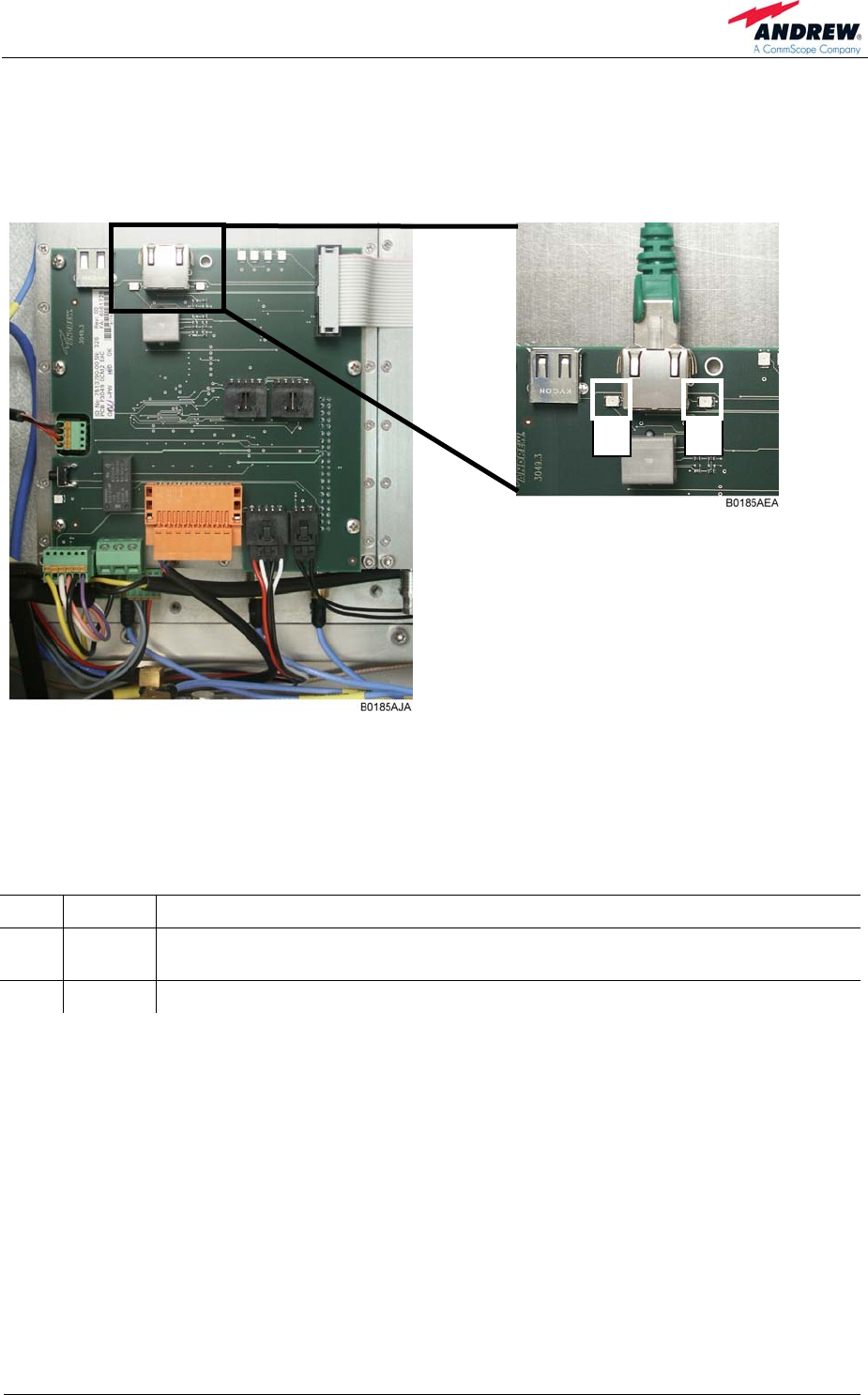
3 Connection Setup
Page 19
3. CONNECTION SETUP
3.1. SETTING UP A LOCAL / LAN CONNECTION FROM LAPTOP / PC
figure 3-1 Ethernet connector RJ45
2
1
Ethernet connector - LEDs
After the connection is made properly, the red and green LEDs near the Node C
network connector will flash.
No Colour Explanation
1 Yellow
LED illuminates when a packet is transmitted by the DCM2 DL
module.
2 Green LED illuminates when a packet is received by the DCM2 DL module.
A standard CAT5 Ethernet cable is supplied to set up a local connection. Open the
Node and plug the cable in the Ethernet connector RJ45 of the EAC-board.
To setup a LAN connection follow the description in the next chapter. A cable is not
provided.
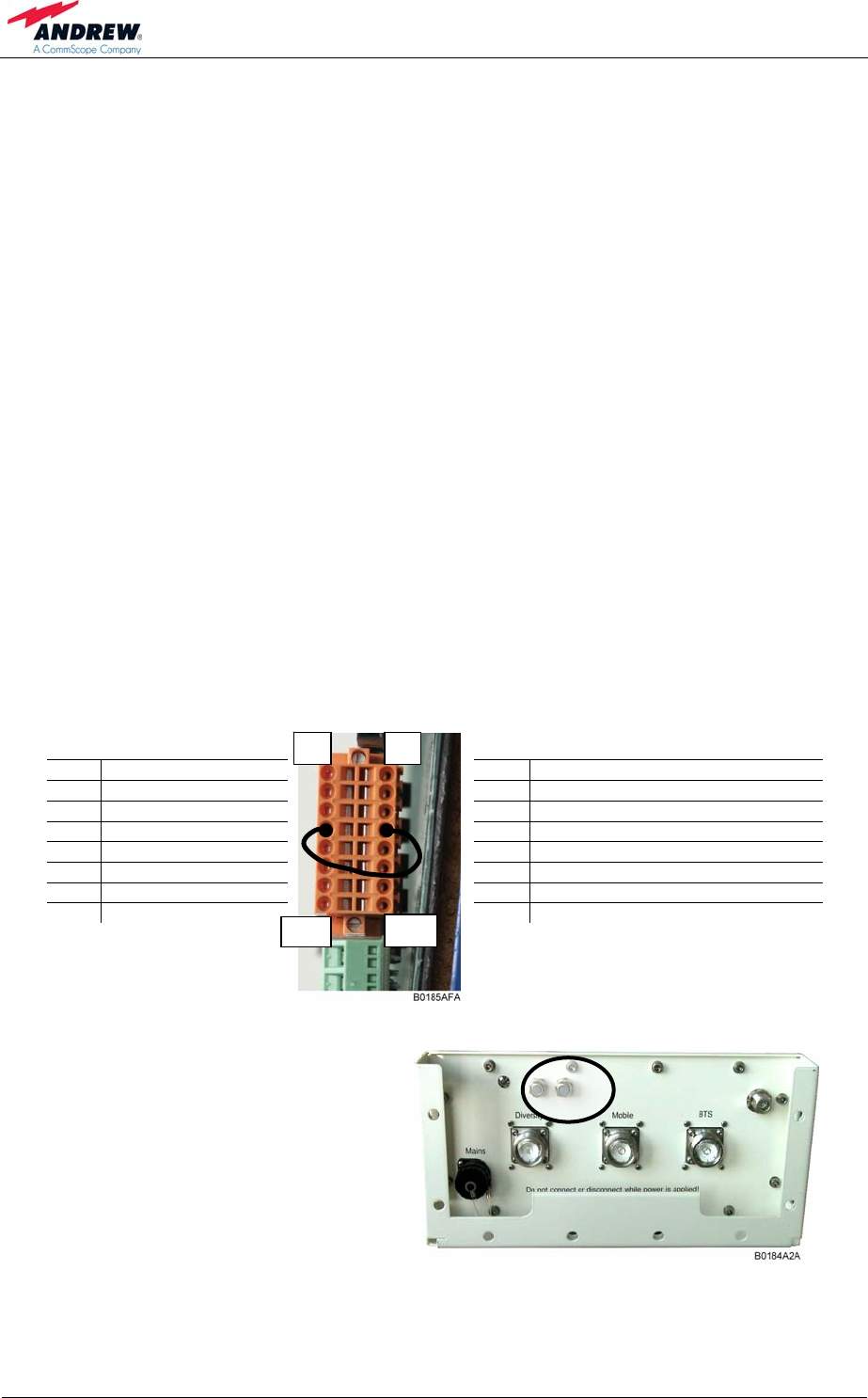
User’s Manual for Node M and Node C
Network Elements
Page 20 M0121A4A.doc
3.2. SETTING UP NODE M/C REPEATER TO RUN AS A LAN ELEMENT
3.2.1. Prerequisites
Use the Local Area Network (LAN) mode to activate DHCP clients or to assign a
static IP address to the Node M/C.
) Note: Before it is possible to configure the LAN settings alarm connectors
7 and 8 must be connected in order to activate External Alarm 1,
figure 3-2 Pin connection.
A local connection via laptop or PC cannot be setup as long as alarm connectors 7
and 8 are connected.
) Note: In the software, LAN Information settings will be activated, if the
main connectivity is set to LAN. Please refer to the software
manual.
For the connection of the Node to the LAN network please use the same type /
category of Ethernet cable as for the connection of the computer to the LAN network.
3.2.2. Procedure
1. Switch off repeater and connect Pin 7 and Pin 8 of the External Alarm connector.
Pin Pin
2 n.c. 1 n.c.
4 GROUND 3 EXT_ALARM_3
6 GROUND 5 EXT_ALARM_2
8 GROUND 7 EXT_ALARM_1
10 PSTN_1_EXTERNAL 9 PSTN_1_INTERNAL
12 PSTN_2_EXTERNAL 11 PSTN_2_INTERNAL
14 GROUND 13 SUMMARY ALARM, LED GREEN
16 GROUND 15 SUMMARY ALARM, LED RED
figure 3-2 Pin connection
2. Switch on repeater
3. Put an Ethernet CAT5 cable
(recommended cable diameter is
4 - 6 mm) through one of the PG7
cable glands into the Node.
figure 3-3 Cable gland position
2 1
15
16
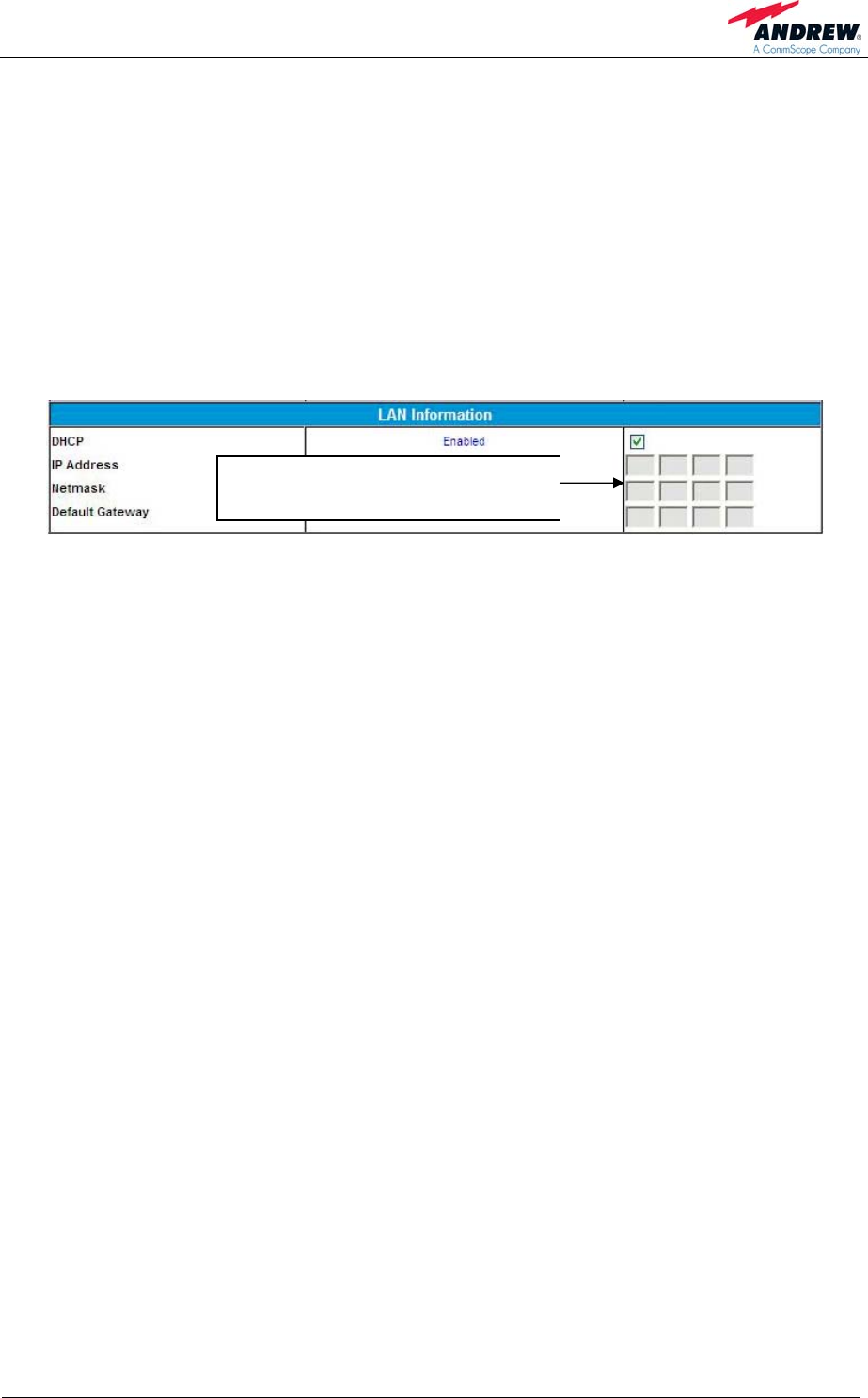
3 Connection Setup
Page 21
4. Crimp the RJ45 connector and connect it to the RJ45 jack of the EAC board. This
is the same connector as for a local connection. See figure 3-1 Ethernet
connector RJ45 on page 19).
5. Fasten the cable glands properly to ensure waterproofness.
6. Configure Main connectivity on the Connectivity page to be LAN so that the
LAN section on the Connectivity page will be activated (for details see software
manual, chapter LAN Information).
7. To enable the DHCP client, set the DHCP check mark. To enter a static IP,
DHCP must be disabled and the IP entry fields will become activated, indicated
by white colour.
Entry fields to set static IP
(white = active; grey = deactivated)
For further details on IP address setting see software manual.
8. Press the Submit button.
9. Connect the Node via the CAT5 cable from Step 3 to the (customer) LAN
network and the Node will get a LAN IP. For more information on LAN IP see
software manual.
3.3. SETTING UP A REMOTE CONNECTION
Use the manual 'Network and Dial-Up Connections - Setup' to establish a remote
connection.
Using the remote connection, the operator can monitor and control the Node M using
the Web browser interface remotely.
In addition, the remote connection may be used for:
An OMC-type software platform (see separate manual)
SMS alarm forwarding

User’s Manual for Node M and Node C
Network Elements
Page 22 M0121A4A.doc
For your notes:
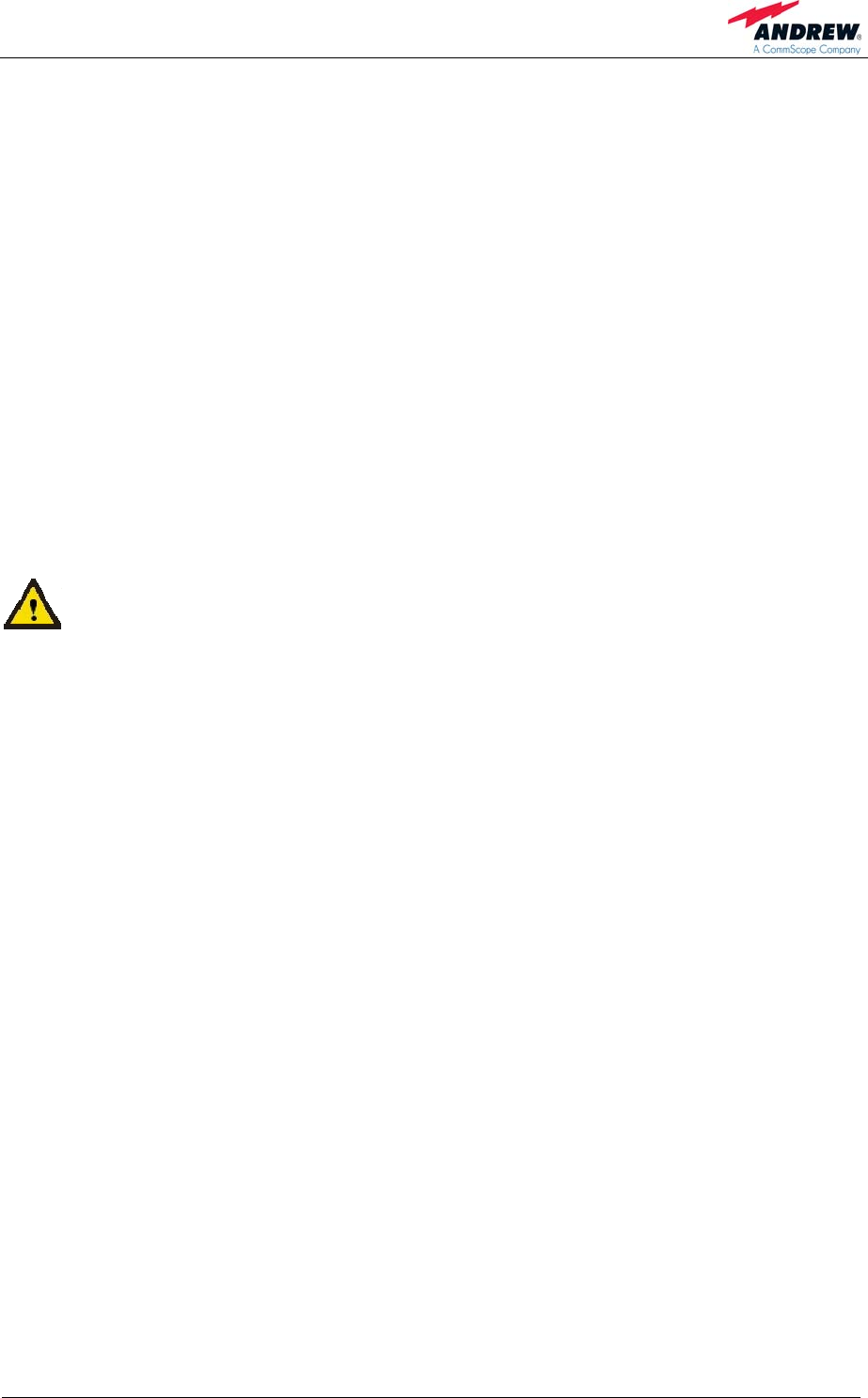
4 Installation
Page 23
4. INSTALLATION
4.1. MECHANICAL INSTALLATION
4.1.1. General
Read the health and safety warnings in chapter 1.2 Health and Safety Warnings.
1. Do not install the unit in a way or at a place where the specifications
outlined in the Environmental and Safety Specifications leaflet of the
manufacturer are not met.
2. It is recommended only to use the mounting hardware delivered by the
manufacturer. If different mounting hardware is used, the specifications
for stationary use of the unit must not be exceeded.
) Note: Exceeding the specified load limits may cause the loss of warranty.
3. The unit is considerably heavy. Make sure that a suitable mounting
surface is used. Ensure there is adequate manpower to handle the
weight of the system.
4. Due to power dissipation, the unit may reach a very high temperature.
Ensure sufficient airflow for ventilation.
Above and below the units a minimum distance of 300 mm to ceiling,
floor, etc. has to be kept. This distance must also be observed between
two units if they are mounted one above the other.
5. When connecting and mounting the cables (RF, mains, ...) ensure no
water can penetrate into the unit through these cables.
If any different or additional mounting material is used, ensure that the mounting
remains as safe as the mounting designed by the manufacturer. Ensure that the
static and dynamic strengths are adequate for the environmental conditions of the
site. The mounting itself must not vibrate, swing or move in any way that might cause
damage to the unit.
) Note: Node M and Node C are delivered with a pre-mounted front cover.
This cover is of vital importance for the correct forced airflow and
for passive cooling. Thus, do not operate the unit without cover.
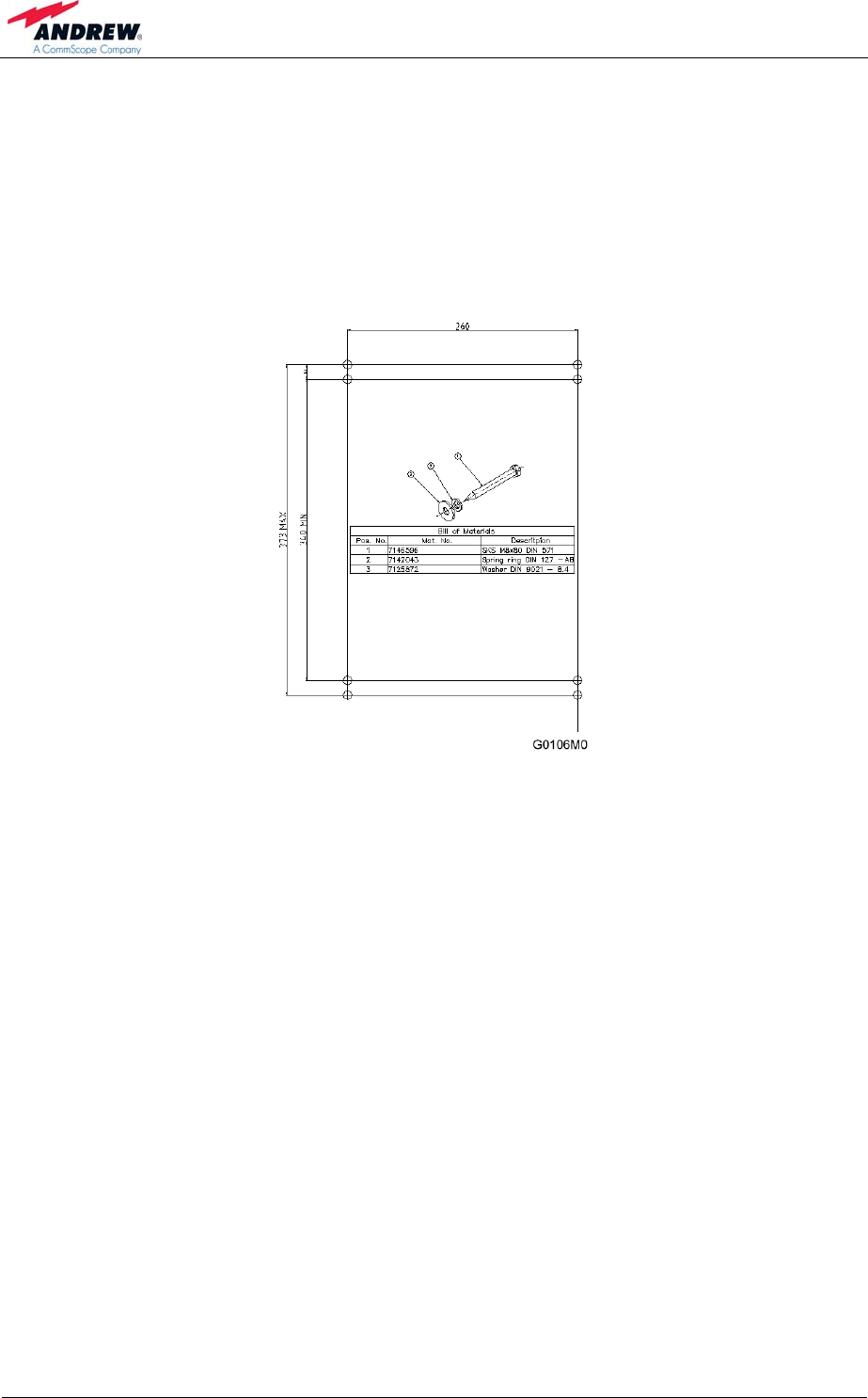
User’s Manual for Node M and Node C
Network Elements
Page 24 M0121A4A.doc
4.1.2. Wall Mounting Procedure
Check the wall mounting kit and the wall to determine their suitability.
Mark the position of the drilling holes - four per unit - for the Node according to
figure 4-1. Please observe that the figure always shows a pair of drill holes for
each position. Only drill one of each pair.
figure 4-1 Positions of drilling holes
) Note: Ensure that there is free access to the electrical connections as well
as to the cabinet. The approved bending radius of the connected
cables must not be exceeded.
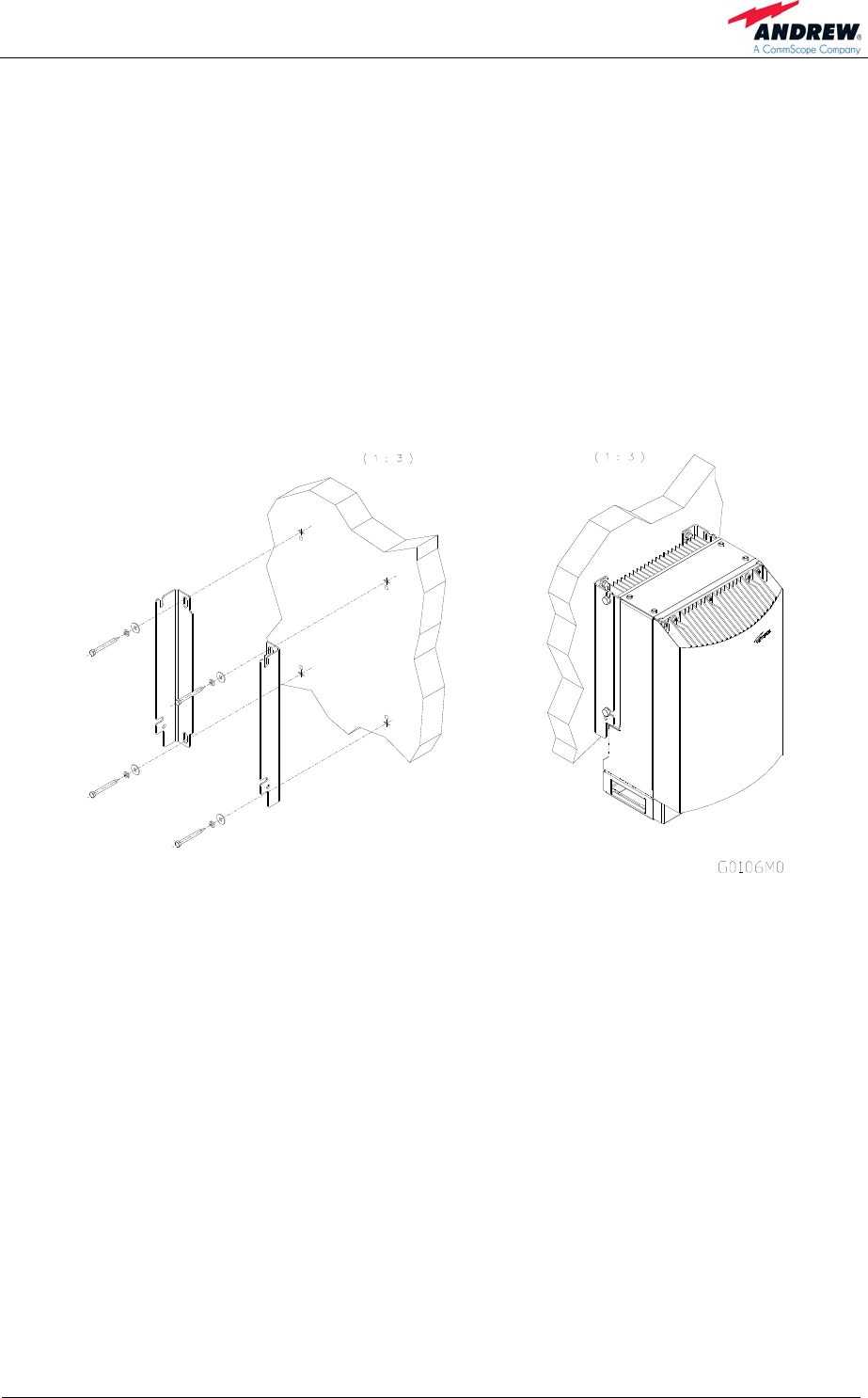
4 Installation
Page 25
Drill four holes (four per unit) at the marked positions and insert dowels*.
* The dowels are not part of the delivery (and thus not illustrated in the figure) since the suitable
type depends on the on-site conditions (the material of wall). Therefore, use dowels that are
appropriate for the mounting surface.
Use a cap nut or locknut to screw the four M8 screws into the dowels.
Use a hex wrench, opening 17 (old standard) or 16 (new standard), to loosen the
M10 hexagon head screws (four per unit) by which the mounting brackets are
fastened to the cabinet sides.
Mount the mounting brackets to the screws, and fasten them using the M8
washers, locking rings, and hex nuts that are part of the wall mounting kit.
Hang the cabinets into the brackets and fasten them with the M10 hexagon head
screws *.
figure 4-2 Wall mounting procedure
* If other screws than the ones delivered by the supplier are used for fastening, these must have
a diameter of at least 8 mm and an appropriate length (depending on the dowels). Additionally,
make sure they are adequate for supporting a maximum weight of 50 kg per unit.
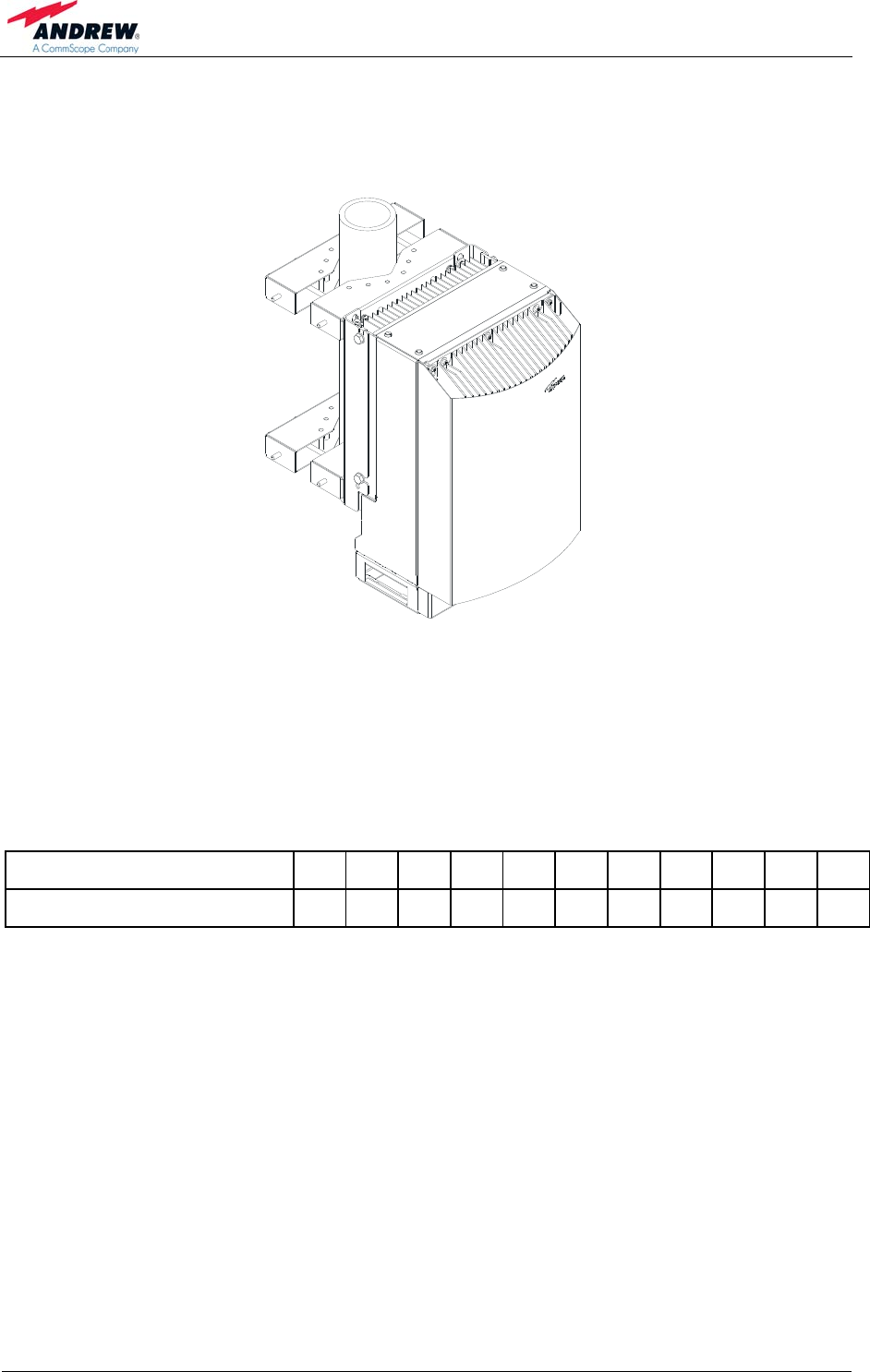
User’s Manual for Node M and Node C
Network Elements
Page 26 M0121A4A.doc
4.1.3. Pole Mounting Procedure
The following figure illustrates the pole mounting option back-to-back.
V14
98
A
0
figure 4-3 Pole mounted units
Before starting the mounting procedure, check the pole diameter of the pole to which
the units will be installed.
Then, cut the thread-bolts (see table 4-2 Components of pole mounting kit, pos. 5) to
the required length according to the following table:
Pole-diameter (mm) 100 110 120 130 140 150 160 170 180 190 200
Length of thread-bolt (mm) 216 226 236 246 256 266 276 286 296 306 316
table 4-1 Required length of thread-bolts
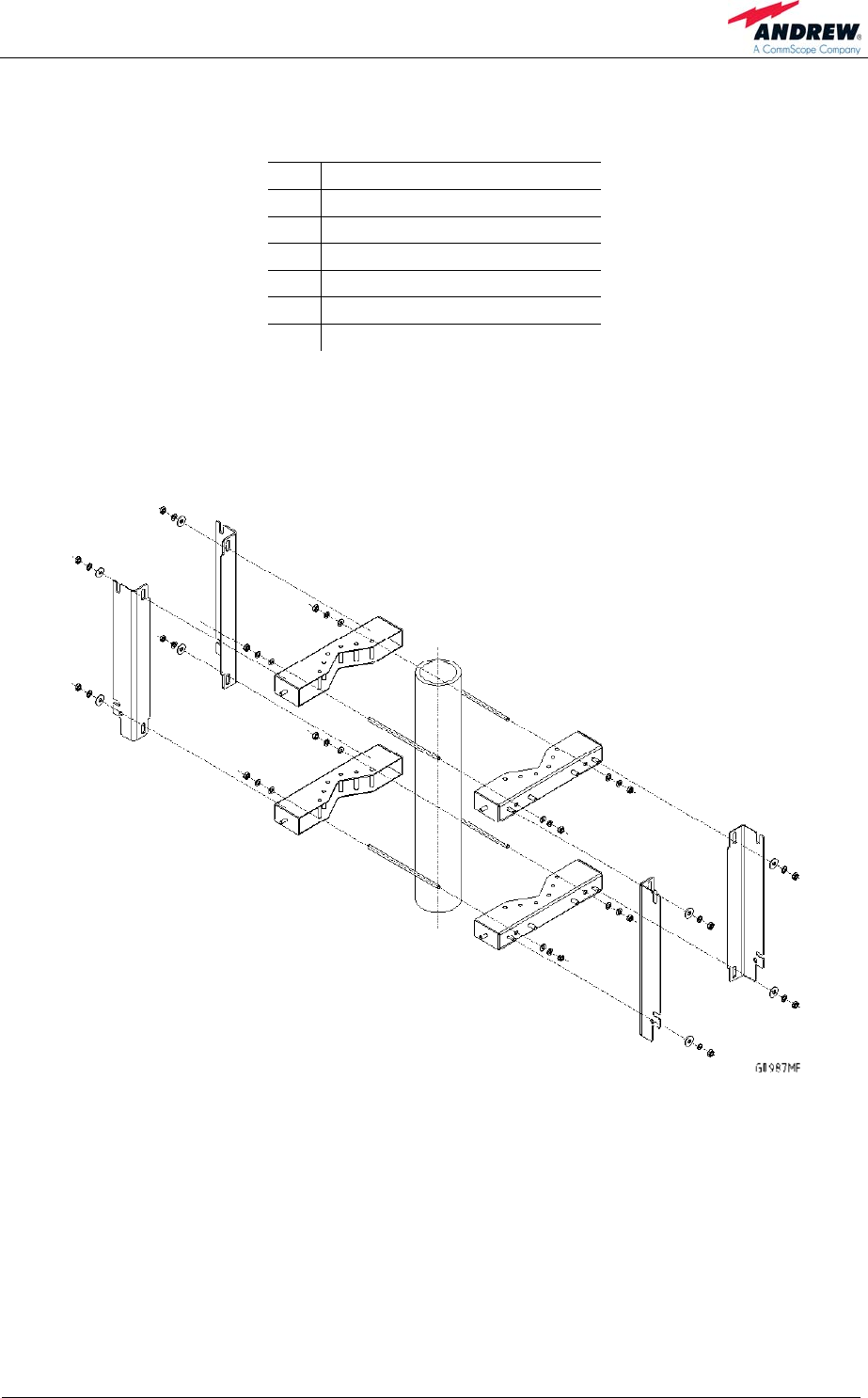
4 Installation
Page 27
The pole mounting kit 'back-to-back' consists of the following parts in different
quantities:
No Part
1 Pole mounting brace
2 Washer DIN 9021 – 8.4
3 Nut M8 DIN 934
4 Spring ring DIN 127 – A8
5 Thread-bolt M8
6 Washer M8 DIN 125
table 4-2 Components of pole mounting kit
The numbers in the above table refer to the numbering of the components in the
following figure.
figure 4-4 Back-to-back pole mounting
Dismount the mounting brackets from the cabinets of the units by loosening the
hexagon head screws M10x20 by which the mounting brackets are screwed to the
housing (four per unit).
Do not unscrew those screws, only loosen them by approx. three turns and take off
the brackets.
Fasten the mounting brackets to the pole using the corresponding mounting kit as
illustrated above.

User’s Manual for Node M and Node C
Network Elements
Page 28 M0121A4A.doc
For your notes:
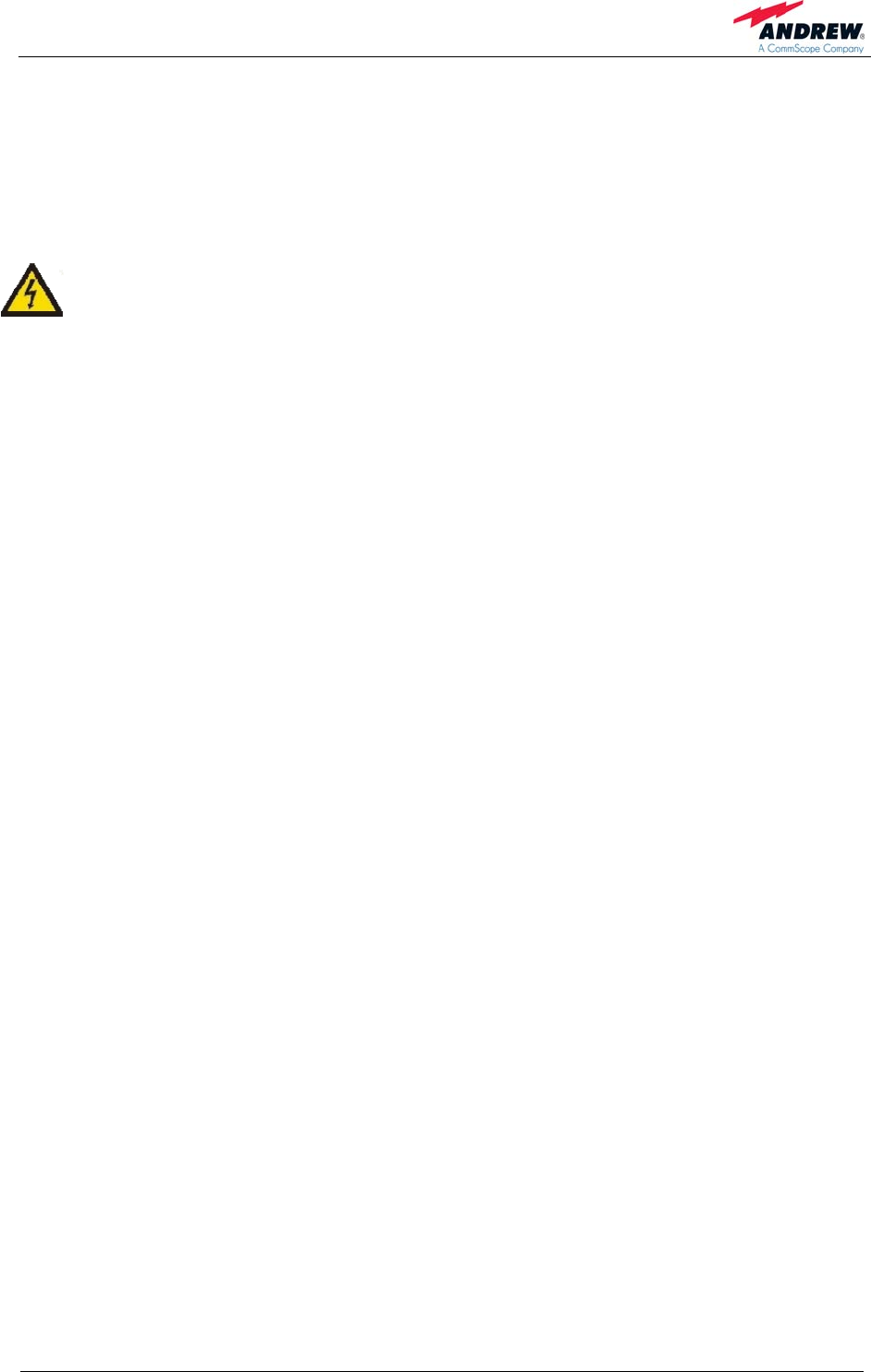
4 Installation
Page 29
4.2. ELECTRICAL INSTALLATION
4.2.1. General
Read the health and safety warnings in chapter 1.2 Health and Safety Warnings.
1. This unit contains dangerous voltages. Loss of life, severe personal
injury or property damage can be the result if the instructions contained
in this manual are not followed.
2. It is compulsory to ground the unit before connecting power supply. A
grounding bolt is provided on the cabinet to connect the ground bonding
cable.
3. Although the unit is internally protected against overvoltage, it is
strongly recommended to earth the antenna cables close to the unit’s
antenna connectors for protection against atmospheric discharge. In
areas with strong lightning it is strongly recommended to insert
additional lightning protection.
4. Hard wired installation of mains supply for the unit requires an easily
accessible separation device in the mains circuit.
5. Make sure that an appropriate circuit breaker and an overcurrent limiting
device are connected between mains and the unit.
6. For unstable electric networks which frequently generate spikes, it is
advised to use a voltage limiting device.
7. A connection of mains supply to a power socket requires the power
socket to be nearby the unit.
8. The mains cable must be used exclusively for the repeater. Do not use
this cable for the power supply of other devices.
9. Incorrectly wired connections can destroy electrical and electronic
components.
10. To avoid corrosion at the connectors caused by electrochemical
processes, the material of the cable connectors must not cause a higher
potential difference than 0.6V (see electrochemical contact series).
11. It is sufficient to tighten the 7/16 or N antenna connector hand-screwed.
Any use of a tool (e.g. pair of pliers) might cause damage to the
connector and thus lead to malfunctioning of the unit.
12. The unit complies with the surge requirement according to EN 61000-4-5
(fine protection), however, it is recommended to install an additional
medium (via local supply connection) and/or coarse protection (external
surge protection) depending on the individual application in order to
avoid damage caused by overcurrent.
13. Observe the labels on the front panels before connecting any cables.
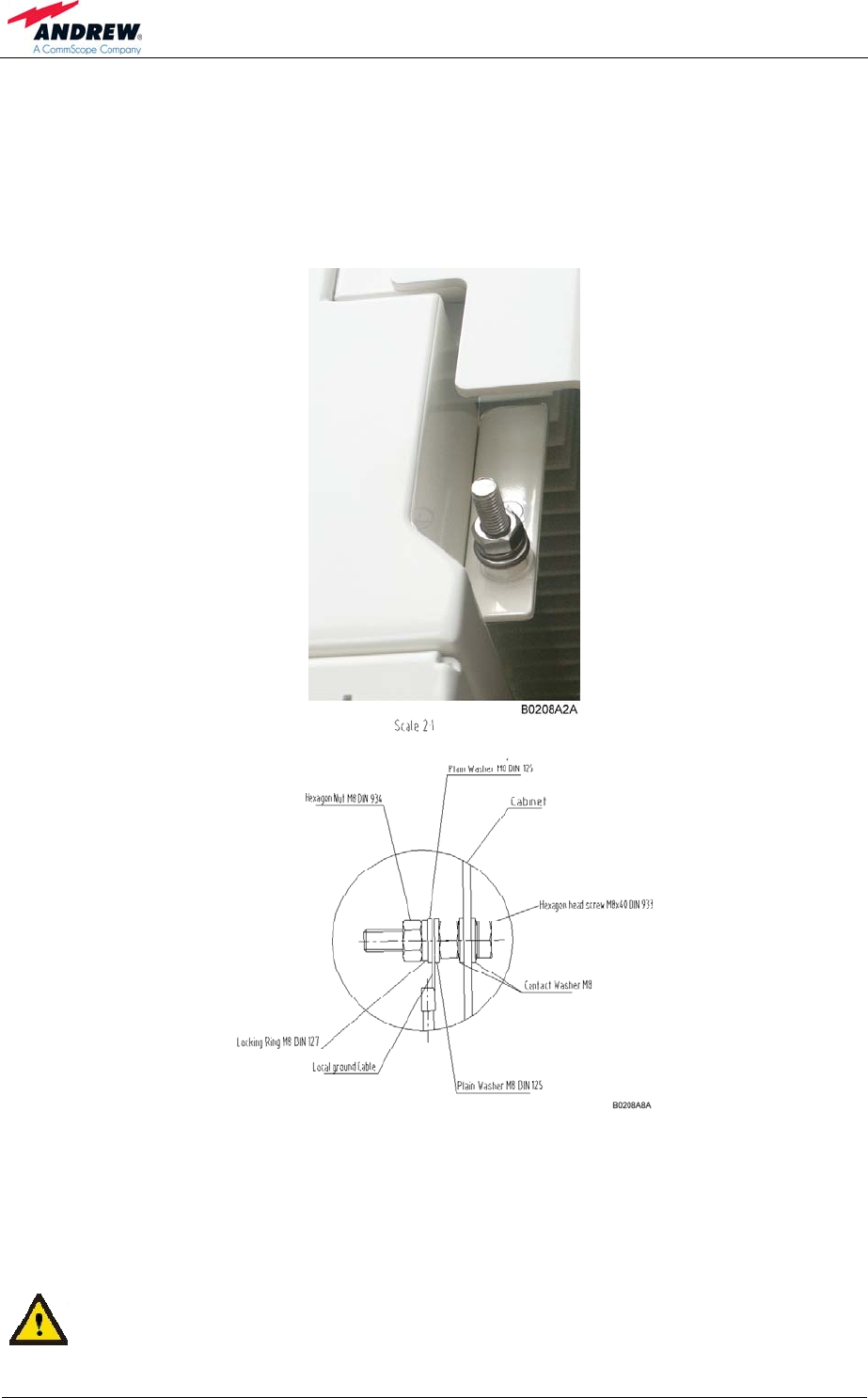
User’s Manual for Node M and Node C
Network Elements
Page 30 M0121A4A.doc
4.2.2. Grounding
Grounding must be carried out. Connect an earth-bonding cable to the grounding
connection provided at the outside of the remote unit. Do not use the grounding
connection to connect external devices.
figure 4-5 Grounding bolt
After loosening the hex nut, connect the earth-bonding cable between the two
washers as illustrated in the figure above. Then, fasten all parts again with the hex
nut.
The PE cables must have a minimum cross section of 10mm2.
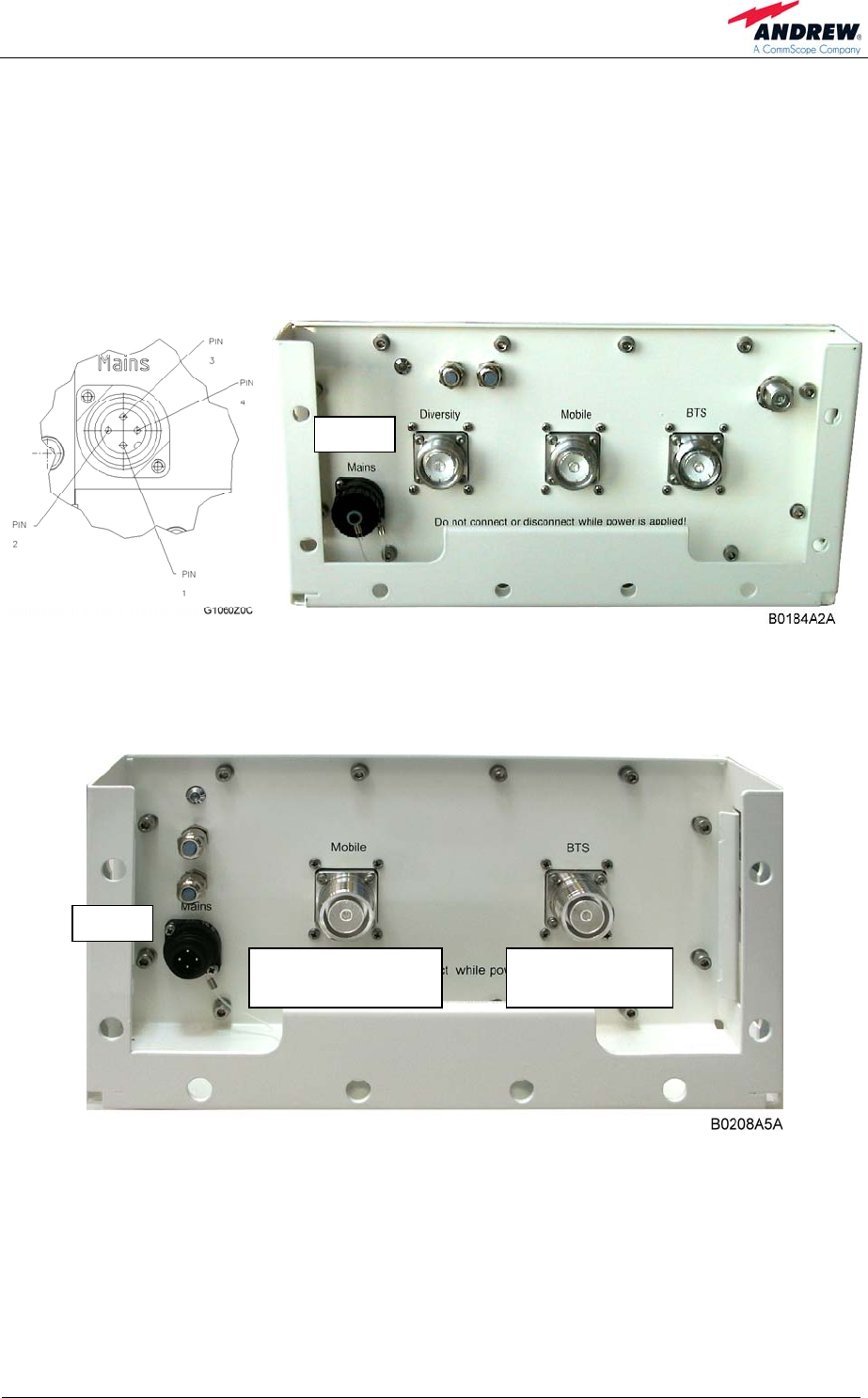
4 Installation
Page 31
4.2.3. Power Connection
Before connecting electrical power to the units, the system must be grounded as
described in the previous chapter. Mains power must be connected at the mains
connector. The power supply plug is included with the Node M/C.
The correct wiring of the power supply plug is as follows:
figure 4-6 Power supply
plug figure 4-7 Mains connector of a Node M, exemplary
Mains
Mains
Coverage antenna Donor antenna
(to mobile) (to base station)
figure 4-8 Mains connector and antenna connections of a Node C, exemplary
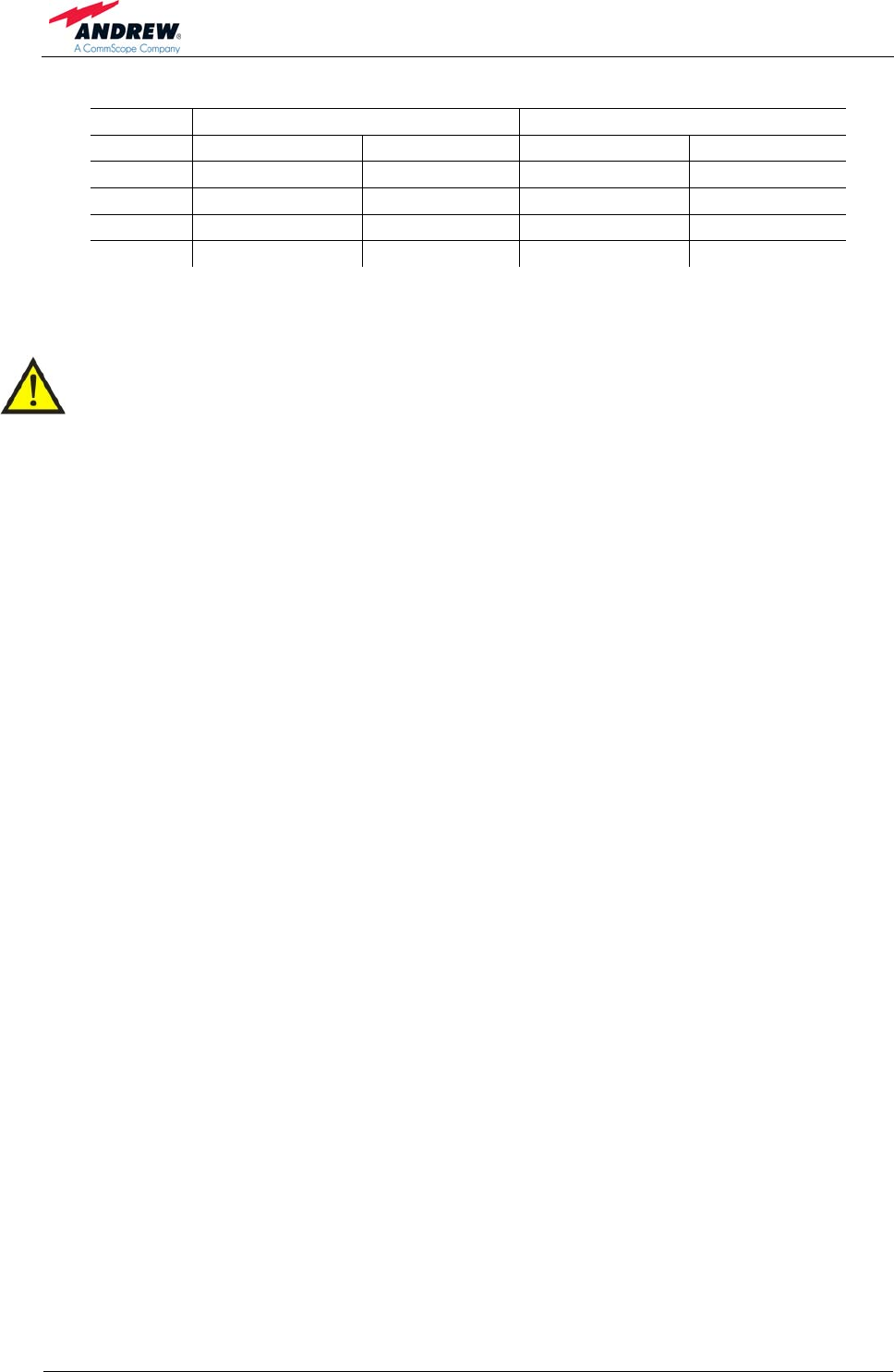
User’s Manual for Node M and Node C
Network Elements
Page 32 M0121A4A.doc
Mains AC Mains DC
PIN Connection Colour Connection Colour
1 Phase brown not connected
2 Neutral blue -Vdc* black
3 not connected +Vdc* red
4 PE green / yellow PE green / yellow
table 4-3 Pin assignment of mains connector
A minimum cross section of 1.5 mm2 is required for the power supply
connection. Each wire must observe the applicable national regulations
regarding loop impedance, voltage drop, and methods of installation. Make
sure to connect the correct voltage to the unit.
) Note: Do not connect or disconnect the power cord at the mains
connector while power is on. Turn off mains** power before
connecting the power cord at the units, then, engage mains again.
* Black is always the negative potential while red is the positive one.
** Mains power must be interrupted with an external AC or DC breaker. For the AC or DC breaker,
observe the following recommendation:
120 Volt / 20 Amp max. or 240 Volt / 16 Amp, single-phase, 50/60 Hz AC service is
needed, i.e. the external AC breaker should be 20 Amps max. for 120-Volt service
or 16 Amps for 240-Volt service.
Option: 48 Vdc (36-72 Vdc). The external DC breaker should be 20 Amps.

4 Installation
Page 33
4.2.4. Connection of the Antenna Cables
The Node M/C’s antenna connectors are 7/16 female (optionally equipped with an N
female adapter). All connectors are located at the bottom of the cabinet. An operator
should refer to the documentation of the cable connector manufacturer for best
mating procedures. Furthermore, the bending radius of the antenna cables should be
maintained at all times.
There are several issues to be considered when selecting the cable and antenna
types.
Highly directional antennas with good front-back-ratios (40 dB is typical) are
recommended because they improve isolation and cell site selectivity.
Smaller diameter cables are less expensive and easier to install but have
worse performance.
Tighten the 7/16 or N connectors ONLY by hand. The use of pliers may cause
damage to the connector and impair the performance of the Node M/C.
Diversit
y
Mobile BTS
Coverage antenna
(to mobile) Donor antenna
(to base station)
figure 4-9 Front view of antenna connections from Node C, exemplary
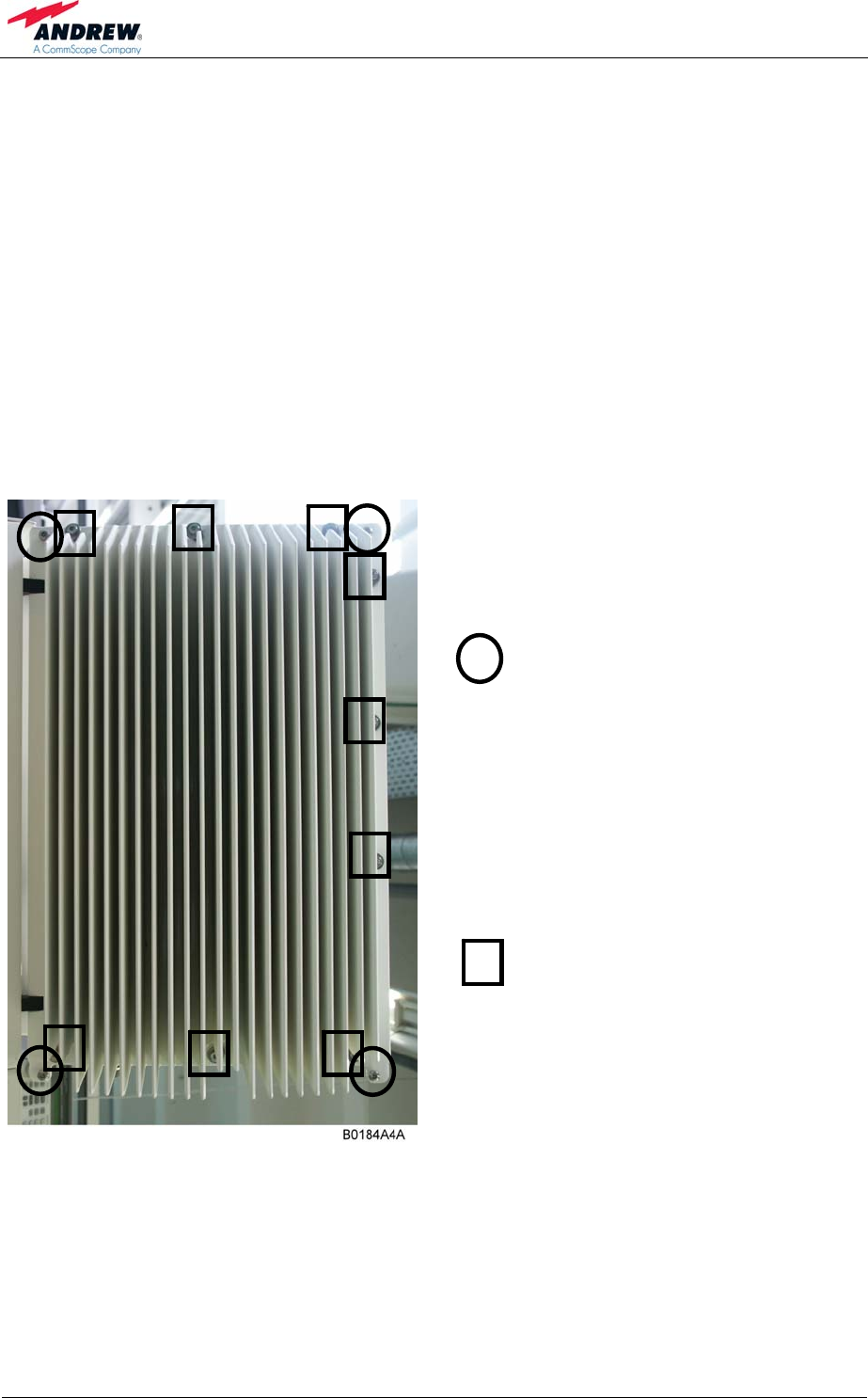
User’s Manual for Node M and Node C
Network Elements
Page 34 M0121A4A.doc
4.2.5. Opening the Cabinet - Mains Power Switch
Read the health and safety warnings in chapter 1.2 Health and Safety Warnings and
observe the following step-by-step procedure.
Do not operate the Node M/C without terminating the antenna connectors.
The antenna connectors may be terminated by connecting them to their
respective antennas or to a dummy load.
Only qualified personnel should carry out the electrical, mechanical,
commissioning, and maintenance activities that require the unit to be powered
on when open.
When opening the Node M/C do not damage the warranty labels on the
internal devices. The warranty is void if the seals are broken.
First remove the front cover
plate by loosening the four front
cover screws. The M5 socket
head cap screws are circle-
marked in the figure to the left.
Do not remove those screws.
When they are loosened, the
front cover plate can be taken
off.
To open the housing, unscrew
the nine M5 socket head cap
screws (captive) of the top
cover.
figure 4-10 Front and top cover screws
) Note: Do not forget to reinstall the front cover afterwards to ensure safe
operation!
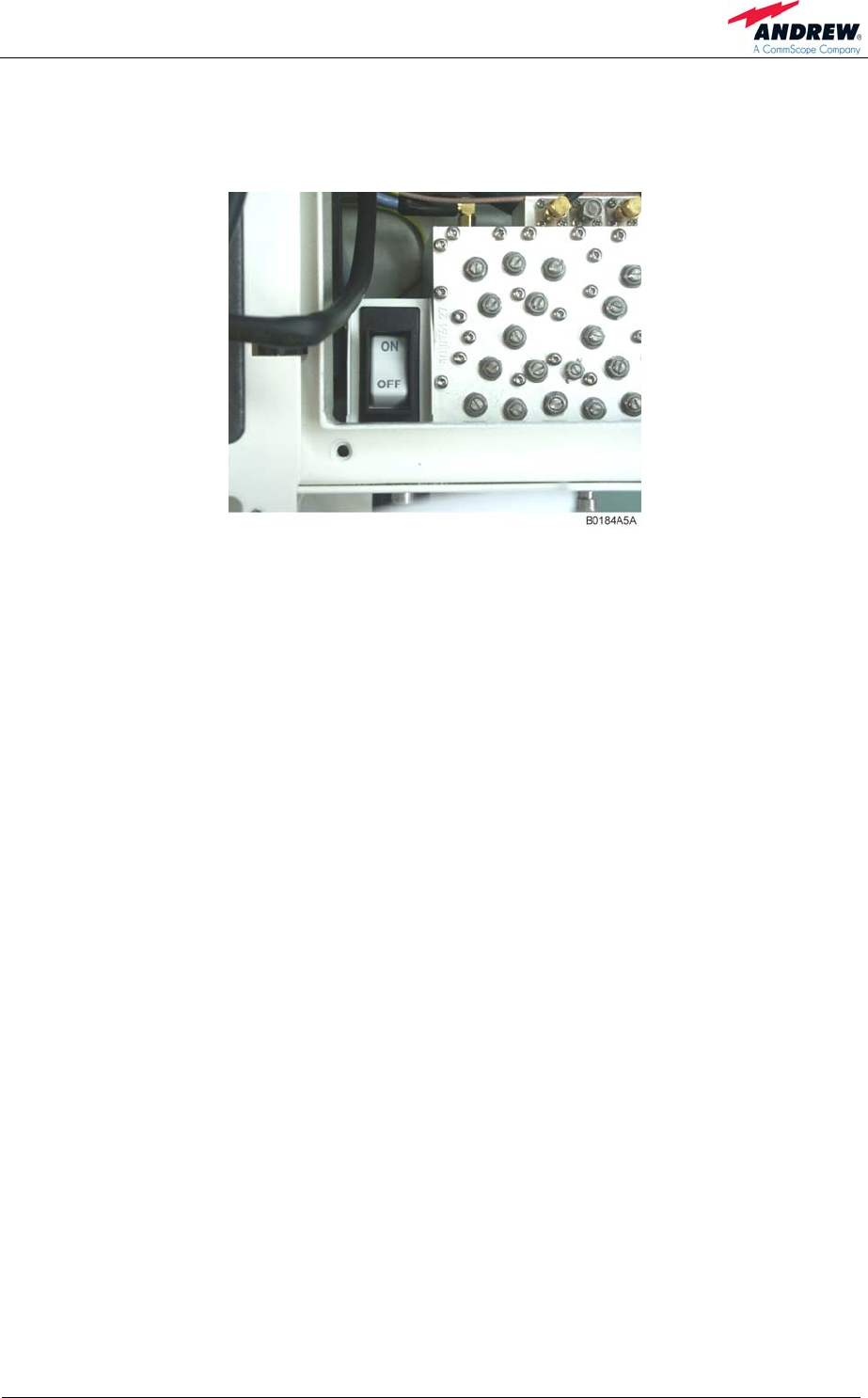
4 Installation
Page 35
) Note: Before closing the unit, make sure that the mains power switch
inside is set to ON.
figure 4-11 Position of mains power switch

User’s Manual for Node M and Node C
Network Elements
Page 36 M0121A4A.doc
For your notes:
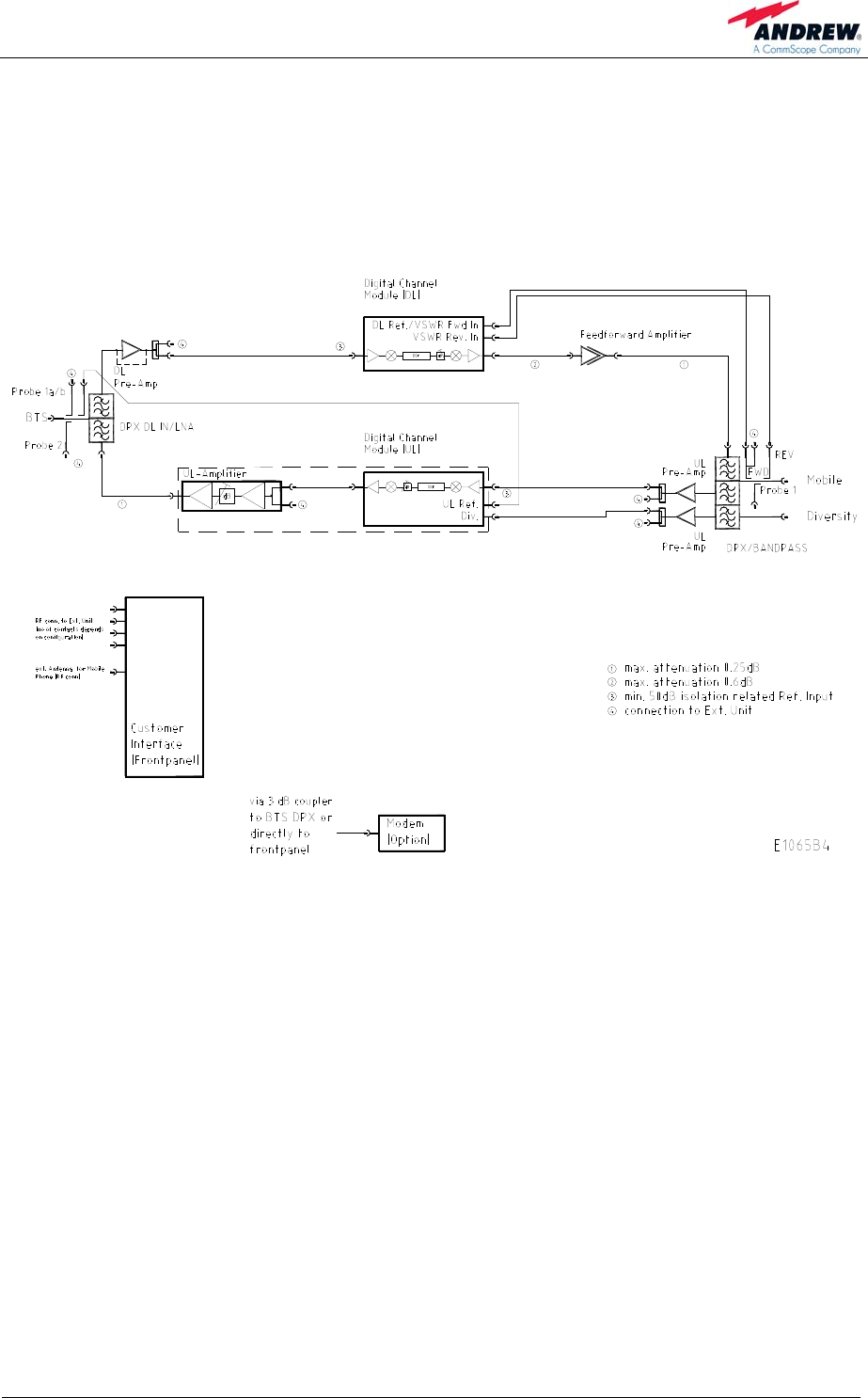
5 Functional Description
Page 37
5. FUNCTIONAL DESCRIPTION
5.1. DIGITAL ARCHITECTURE
The following figure shows the RF block diagram of the Node M/C.
figure 5-1 Configuration of a network element
The Node M/C is designed to amplify signals between multiple mobiles and a base
station in a UMTS/CDMA system. The unit consists of a filter and amplifier chain in
the downlink and one or two filters and amplifier chains in the uplink (primary and
diversity). The uplink and downlink paths are connected via a duplexer on both ends
of each path.
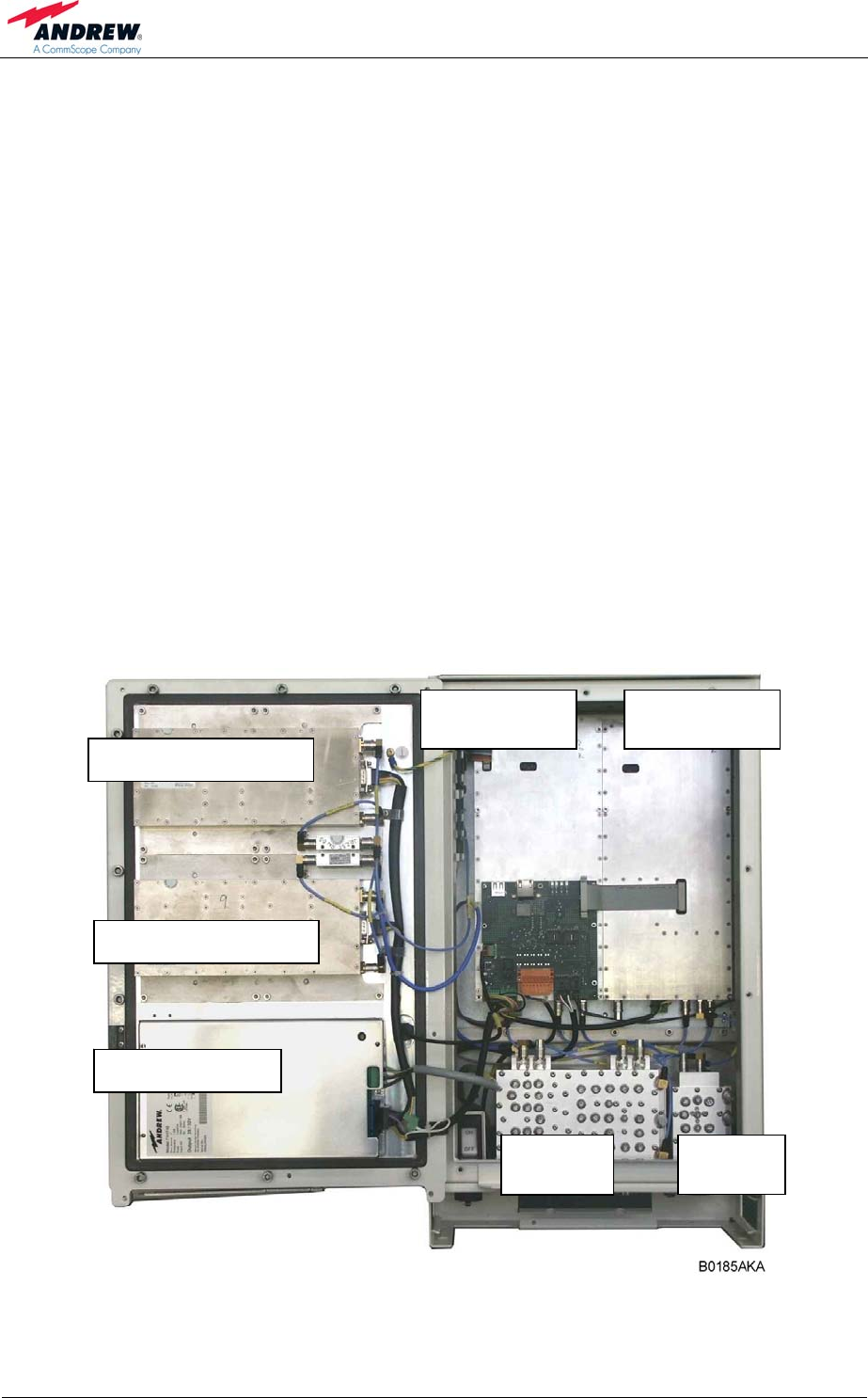
User’s Manual for Node M and Node C
Network Elements
Page 38 M0121A4A.doc
In the primary uplink path, a signal originating from the mobile is separated from the
downlink signal via the primary UL IN duplexer. It is then amplified by an integrated
low noise amplifier (LNA) and forwarded to the uplink digital channel module (DCM).
The DCM down-converts the signal to base-band, digitally filters it, amplifies it and
then up-converts it. In addition the interference cancellation technology is
implemented in the DCM. Finally, the signal is sent to the final amplifier (included in
DCM) and combined with the downlink input signal in the DL IN duplexer. The
optional diversity uplink path (via a second filter) is identical except signals enter via
the diversity UL IN duplexer and are combined in the DCM with the primary path.
In the downlink path, a signal originating from the base station is separated from the
uplink signal in the DL IN duplexer. It is then amplified by an integrated low noise
amplifier (LNA) and forwarded to the downlink digital channel module (DCM). The
DCM down-converts the signal to base-band, digitally filters it amplifies it and then
up-converts it. In addition the interference cancellation technology is implemented in
the DCM. Finally, the signal is sent to the final amplifier and combined with the uplink
input signal in the primary UL IN duplexer. The downlink DCM is also responsible for
communication and control of the entire unit.
Using a Node C 843 as an example, the following figure illustrates the positions of
the RF components inside the Node M/C.
Digital channel
module DL Digital channel
module UL
Downlink final amplifier
Downlink final amplifier
Power supply unit
Coverage
duplexer Donor
duplexer
figure 5-2 RF path of a Node C 843, exemplary
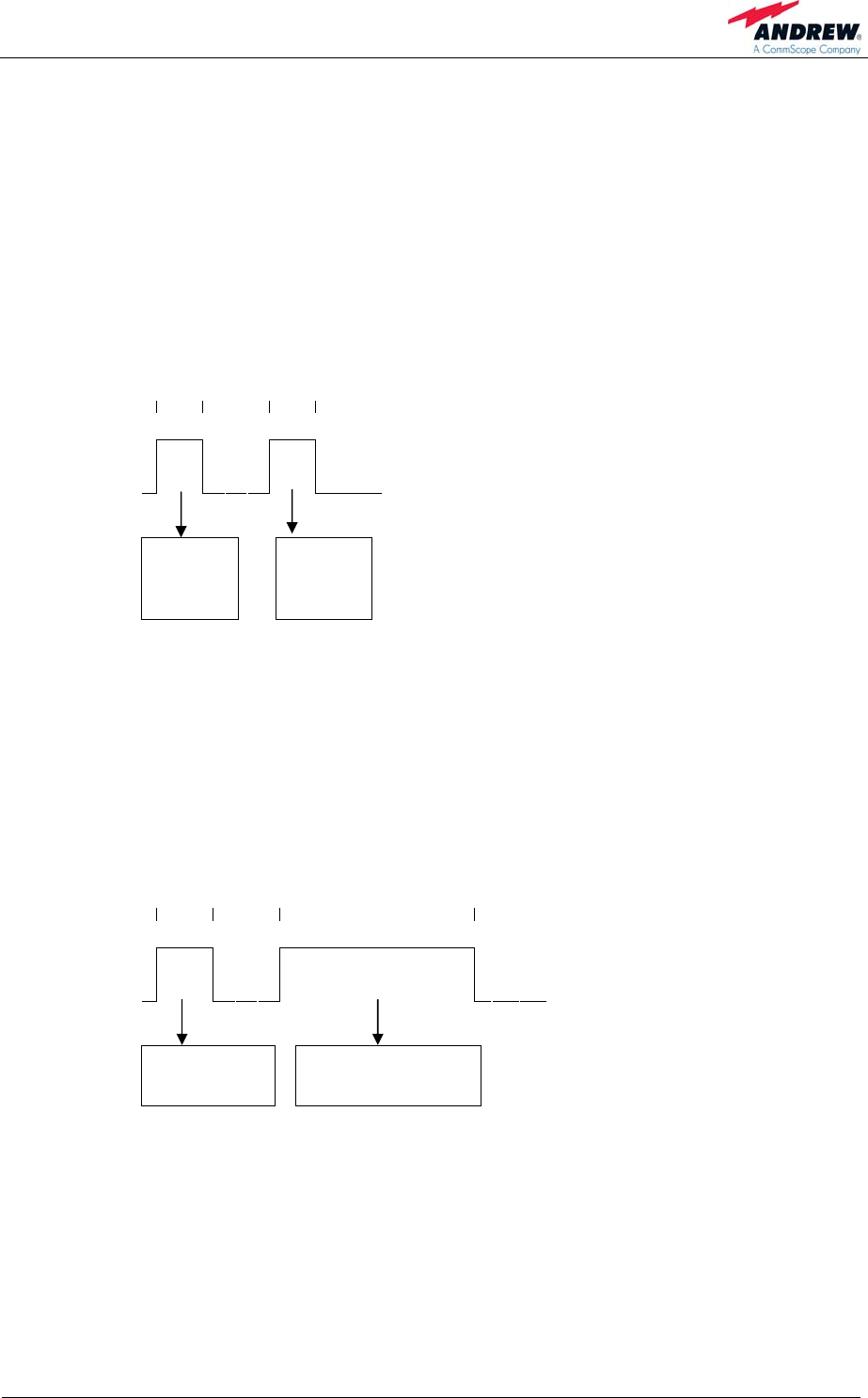
5 Functional Description
Page 39
5.2. FEATURES
5.2.1. Filters Node M
Filters are set automatically according to the channels set in “Setup Wizard” or
“Technician Setup”. For further information about these menus refer to the user's
manual for Node software.
UMTS - Possible filters are:
5 5 MHz
One
UMTS
channel
One
UMTS
channel
5.2.2. Filters Node C
Filters are set automatically according to the channels set in “Setup Wizard” or
“Technician Setup”. For further information about these menus refer to the user's
manual for Node software.
CDMA - Possible filters are:
1.23 16 x 1.23 MHz
one CDMA
channel sixteen adjacent
CDMA channels

User’s Manual for Node M and Node C
Network Elements
Page 40 M0121A4A.doc
5.2.3. Digital ICE (Digital Interference Cancellation Equipment)
Digital ICE has been developed to enhance antenna isolation. This feature enables
the Node M/C to provide coverage in areas where effectivity is decreased due to
physical site limitations which cause insufficient antenna isolation.
Antenna isolation is the RF loss measured between the donor antenna and the
coverage antenna. If the gain of the network element exceeds the path loss,
feedback in form of oscillation occurs. The isolation is usually dominated by the direct
path loss from one antenna to the other, but reflections can contribute to or even
affect antenna isolation. Digital ICE cancels the signal from the primary feedback
path, thus allowing the gain of the network element to be increased.
The required delay resulting from the on-site conditions is measured by the DCM and
set accordingly.
For software setting commands please refer to the online help screens.
The Digital ICE function can be enabled or disabled in the “Technician Setup” page.
Isolation and gain margin* can be checked in the “Status and Reports” menu
accessible via the home page of the web interface (see software manual).
* gain margin = antenna isolation minus Node M/C gain
5.2.4. VSWR (Voltage Standing Wave Ratio)
This feature enables the provider to query the status of the antenna system (antenna
and cable). The voltage standing wave ratio of the DL output antenna port is
measured.
If the VSWR falls below the value set in the Alarming Management of the software,
an alarm is released. The alarm can be forwarded to the OMC where the faults and
irregularities can be acknowledged and eliminated promptly.
The current VSWR value can be checked in the “Status and Reports” menu
accessible via the home page of the web interface.

5 Functional Description
Page 41
5.2.5. RSSI (Receive Signal Strength Indication)
The RSSI provides controlling and monitoring of the receive level of a base station
(DL RSSI) or user equipment (UL RSSI) to a Node M/C. It measures the level of the
input signal by detecting the RF and converting the analogue level into a digital
value. The data are processed and evaluated by software. An alarm will be released
if the measured signal level exceeds the alarm level set by the provider via software.
) Note: If the Node M/C is equipped with a diversity path, both values will be
combined before the RSSI evaluation. Thus, only one UL value is
reported.
The current RSSI values can be checked in the “Status and Reports” menu
accessible via the home page of the web interface.
5.2.6. Alarm Forwarding
Alarms can be forwarded to a defined phone number or to the OMC if the Node M/C
is equipped with a modem or a mobile station. This enables the provider to control
and to query the status of the network via pocket switched or circuit switched
connection. Faults and irregularities can be recognized and eliminated.
With an optional modem the Node M/C also provides an SMS feature, by which the
unit is able to send out alarm messages as SMS. For further details please contact
your supplier.
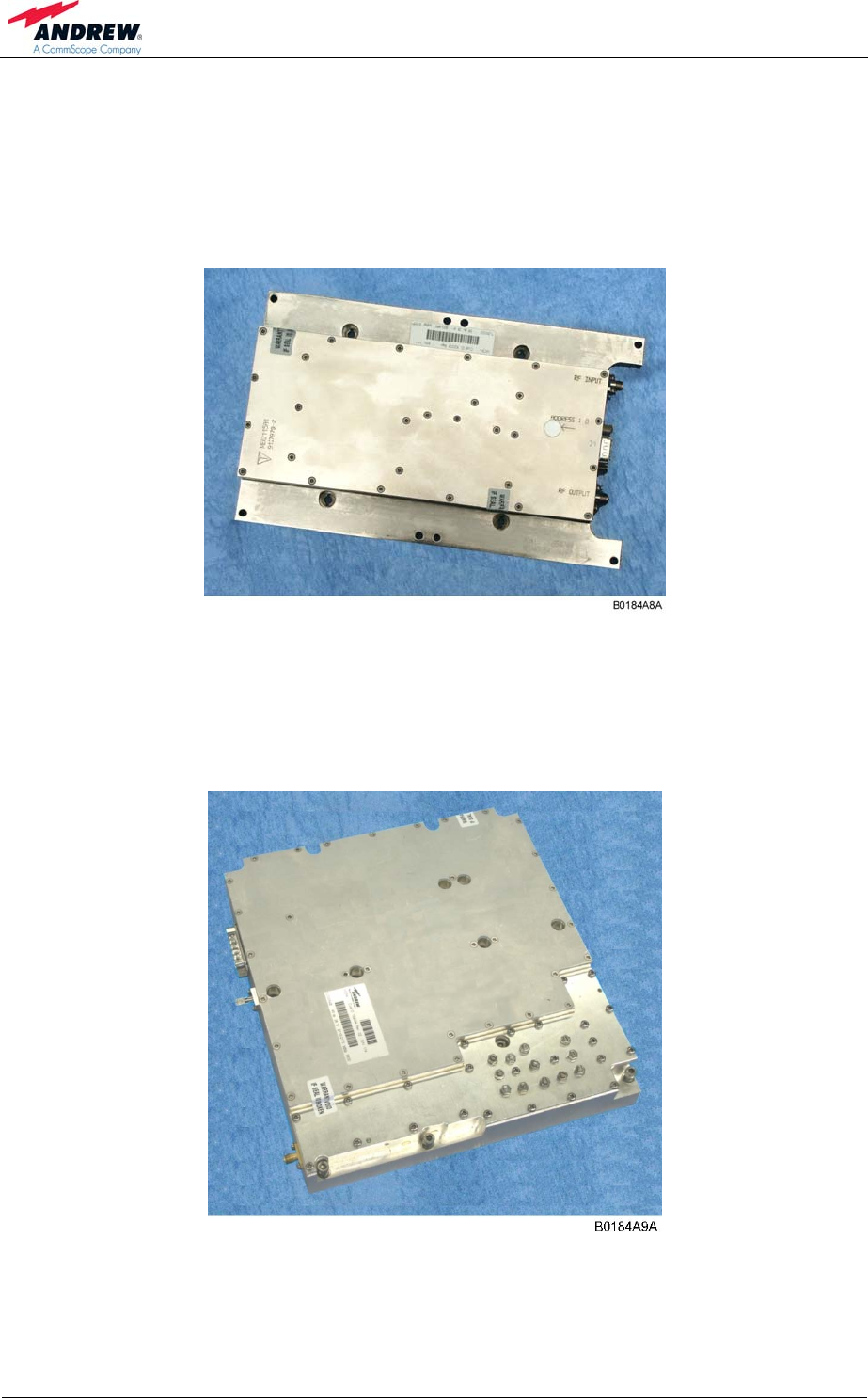
User’s Manual for Node M and Node C
Network Elements
Page 42 M0121A4A.doc
5.2.7. Downlink Final Amplifier
For the Node M/C x37 an MCPA (multi carrier power amplifier) is used.
This is an error-correcting feed-forward amplifier. It has a high output power while
maintaining superior intermodulation and linearity performance.
figure 5-3 Node M/C x37 MCPA DL final amplifier
For the Node M/C x43 an MCPA (multi carrier power amplifier) with more output
power is used. This is an error-correcting feed-forward amplifier. It has a high output
power while maintaining superior intermodulation and linearity performance.
figure 5-4 Node M 2143 and Node M 1943 MCPA DL final amplifier

5 Functional Description
Page 43
figure 5-5 Node M/C 843 DL final amplifier
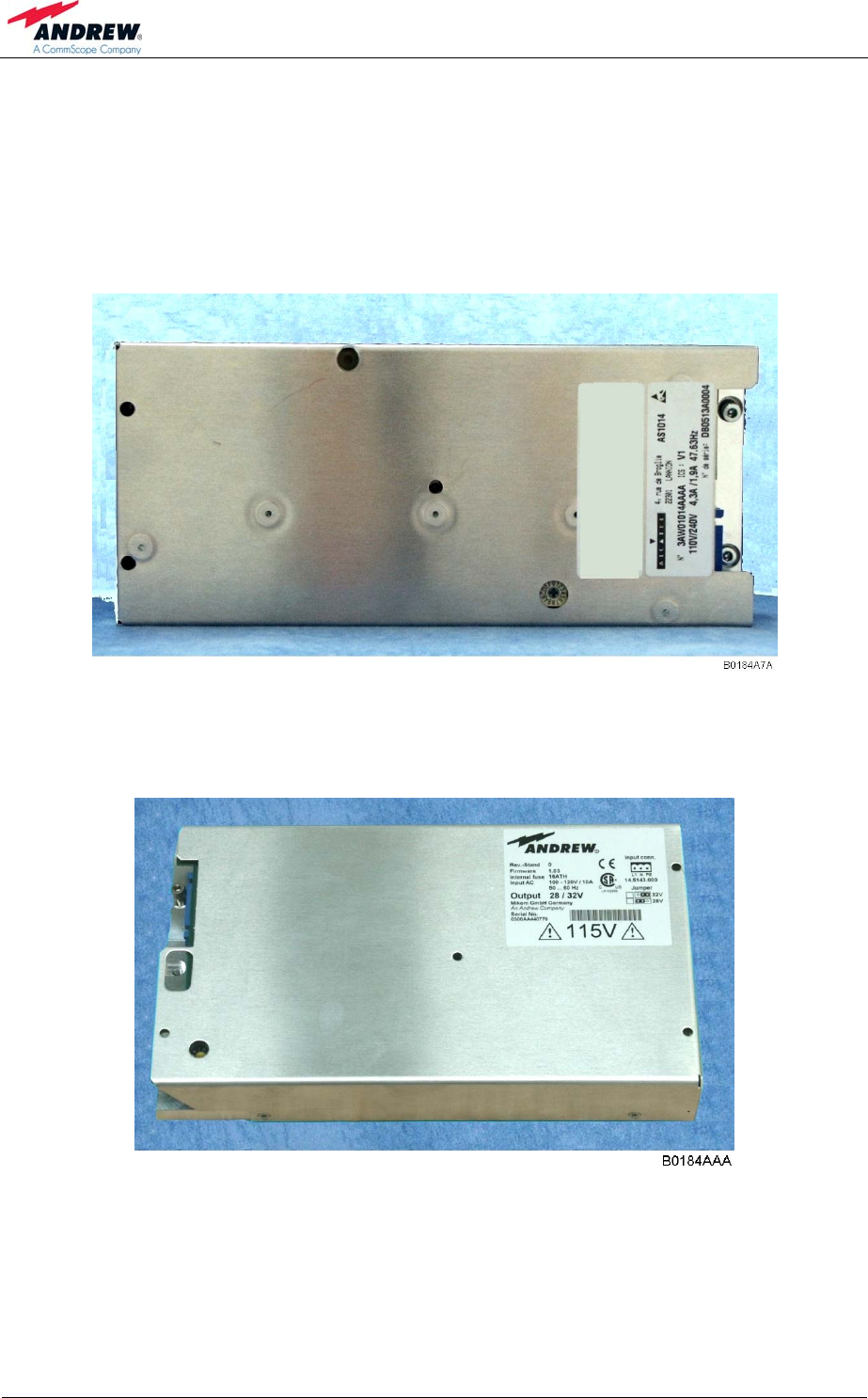
User’s Manual for Node M and Node C
Network Elements
Page 44 M0121A4A.doc
5.2.8. Power Supply Unit
The power supply unit is mounted in the door of the Node.
This device transforms mains power into a predefined DC voltage. When performing
maintenance, ensure that all circuits are voltage-free and that the Node M/C is
disconnected from mains.
figure 5-6 Power supply, Node M/C x37
figure 5-7 Power supply, Node M/C x43
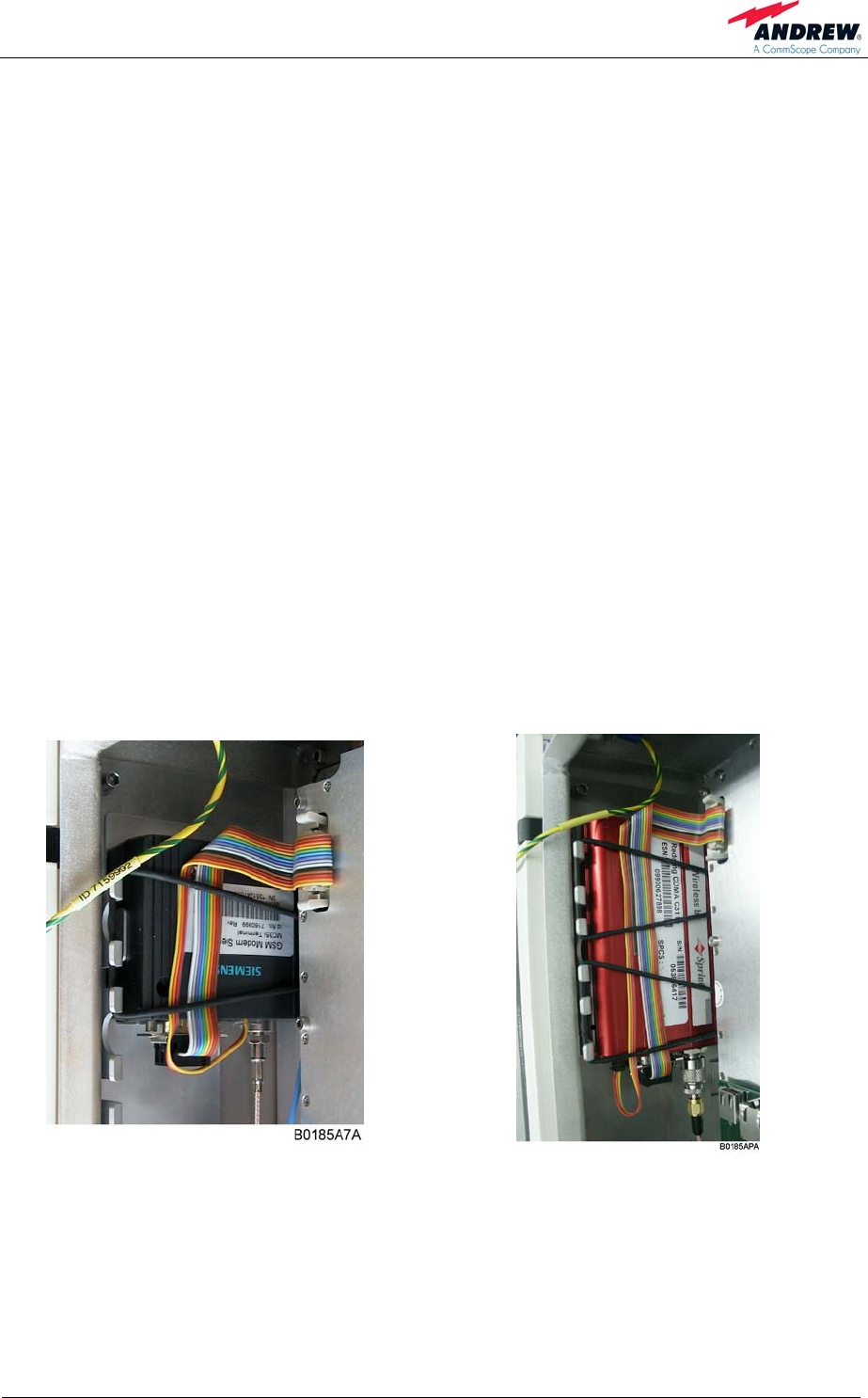
5 Functional Description
Page 45
5.2.9. Modems
The modem is used to establish a remote connection to the Node M/C. The
connection may be used to change the parameters of the unit, check and clear
alarms or collect measurement and quality statistics.
Furthermore, the modem is at the Node M/Cs request to alert the operator when
there is an alarm. The modem may be over-the-air (wireless) or public switched
telephone network (PSTN). It is possible to install the wireless modem or the PSTN
modem on site.
Modem communication settings may only be changed locally. Should a different
modem be used, the operator should ensure that the settings are changed prior to
leaving the site.
Wireless modems allows remote control and maintenance of the Node.
Parameters may be changed; alarm and measurement statistics may be
acknowledged and collected in the OMC.
5.2.9.1. Illustrations of Modems
) Note:
The modems MC55, MC56, MC75
and HC25T are similar to modem
MC35.
) Note:
The modem Raven C3211 is similar to
modem Redwing.
figure 5-8 Modem MC35 figure 5-9 Redwing modem (CDMA)
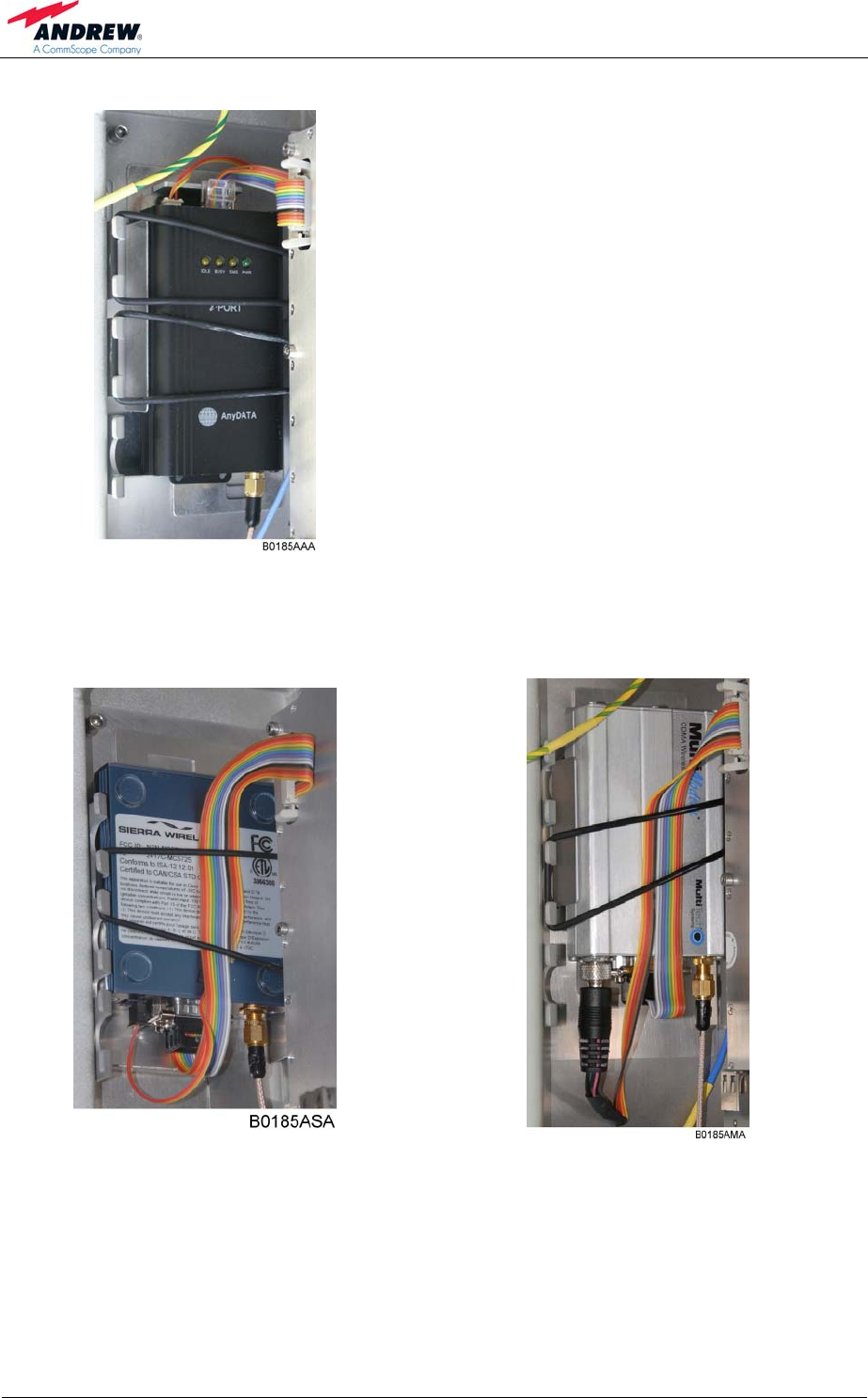
User’s Manual for Node M and Node C
Network Elements
Page 46 M0121A4A.doc
figure 5-10 Modem AnyDATA iPORT
EMIII Dual / EM IV Dual
figure 5-11 Modem Raven XT figure 5-12 Modem MTCBA-C-N9
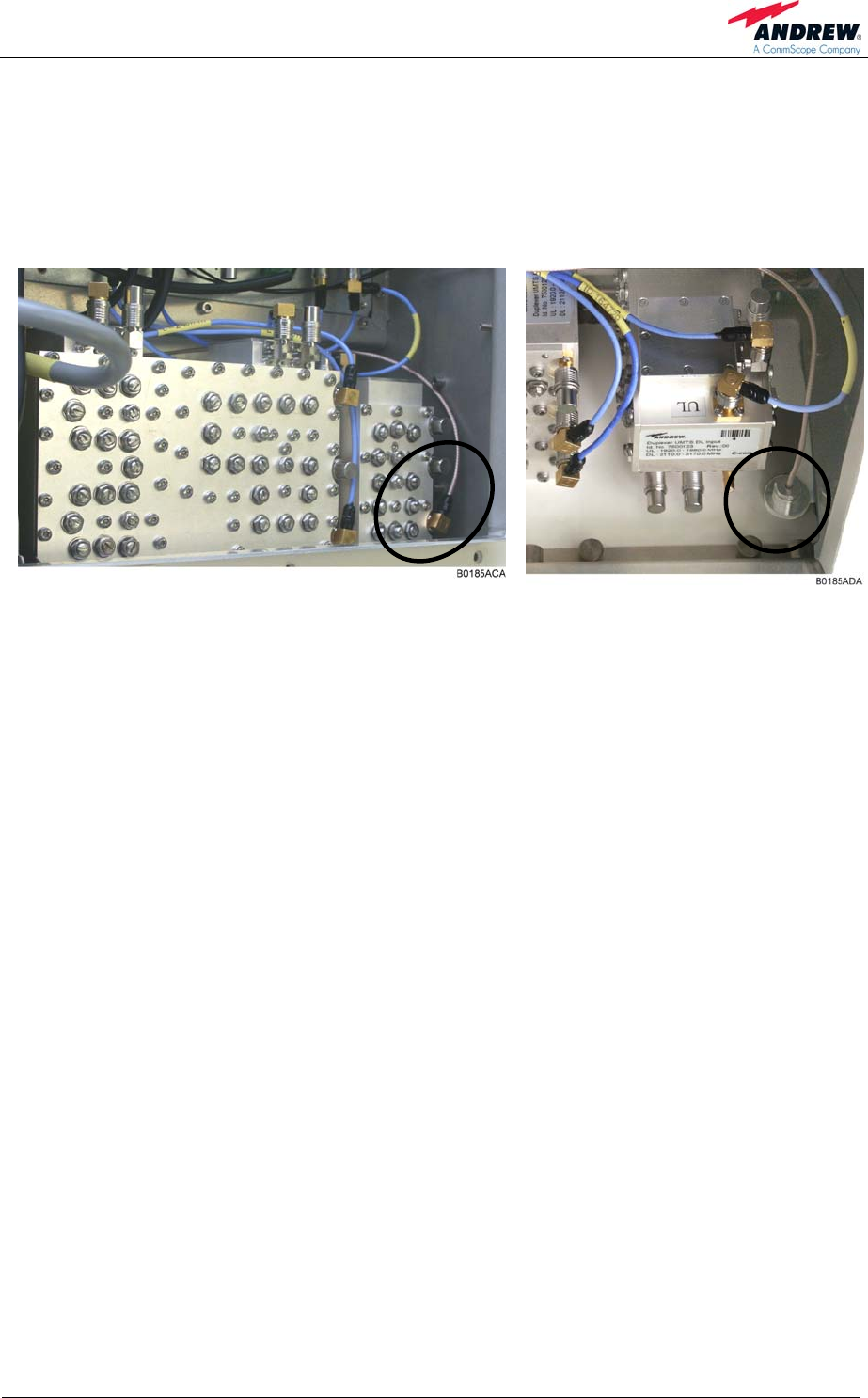
5 Functional Description
Page 47
5.2.9.2. Modem Output
The modem output is connected to the 20 dB modem coupler port of the DL IN
duplexer or to the N-female connector near to the BTS port to connect an external
antenna.
figure 5-13 Cable from modem to donor
duplexer
figure 5-14 Cable from modem to
external modem antenna port;
Node M
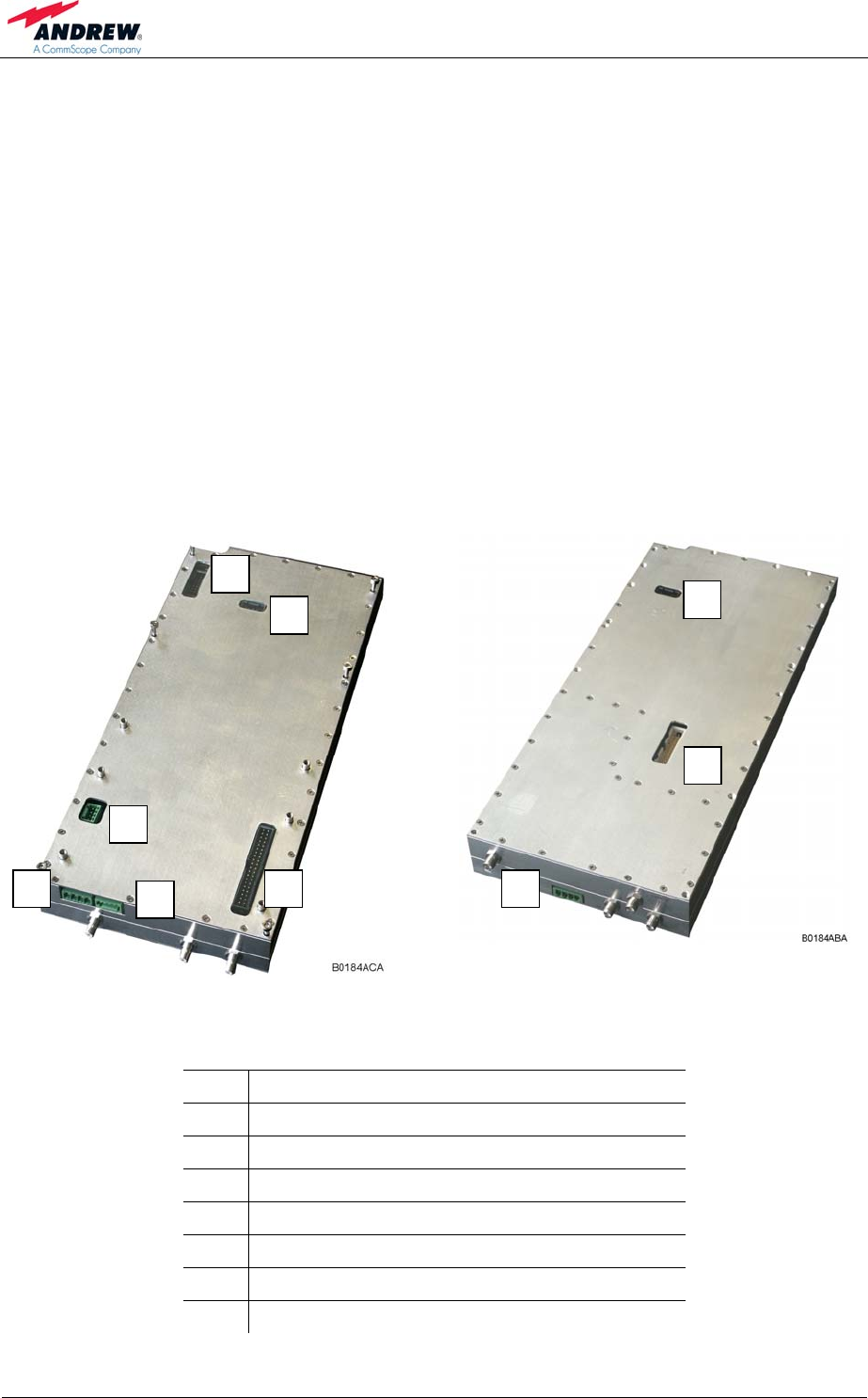
User’s Manual for Node M and Node C
Network Elements
Page 48 M0121A4A.doc
5.2.10. Digital Channel Module (DCM)
The task of the digital channel module (DCM) is to filter and amplify any signals
passing through it. In addition it takes measurements of the input and output signals
and decodes the air interface to ensure proper setup and operation.
Finally it performs the interference cancellation algorithms, which eliminate the
normal problems associated with isolation, and has an integrated controller (in the DL
part) for the entire Node M/C, which maintains a web server for local and remote
communication. This process is accomplished by both analogue and digital means.
In case the diversity option is equipped, the module receives signals from both the
primary duplexer and diversity filter. Both signals are combined digitally and filtered
before being amplified in the uplink amplifier.
The DCM consists of an DL and UL part.
figure 5-15 Digital channel module,
DL part figure 5-16 Digital channel module,
UL part
1
2
2
7
3
4 6 4
5
No Explanation
1 1 Vdc and remote (RS232) for modem
2 Debug-connector
3 Fan connector (Node x43)
4 Vdc DL digital channel module
5 Battery backup connector
6 EAC-board connector
7 Internal DCM - DCM interface connection
1 Only one modem can be used at the same time.
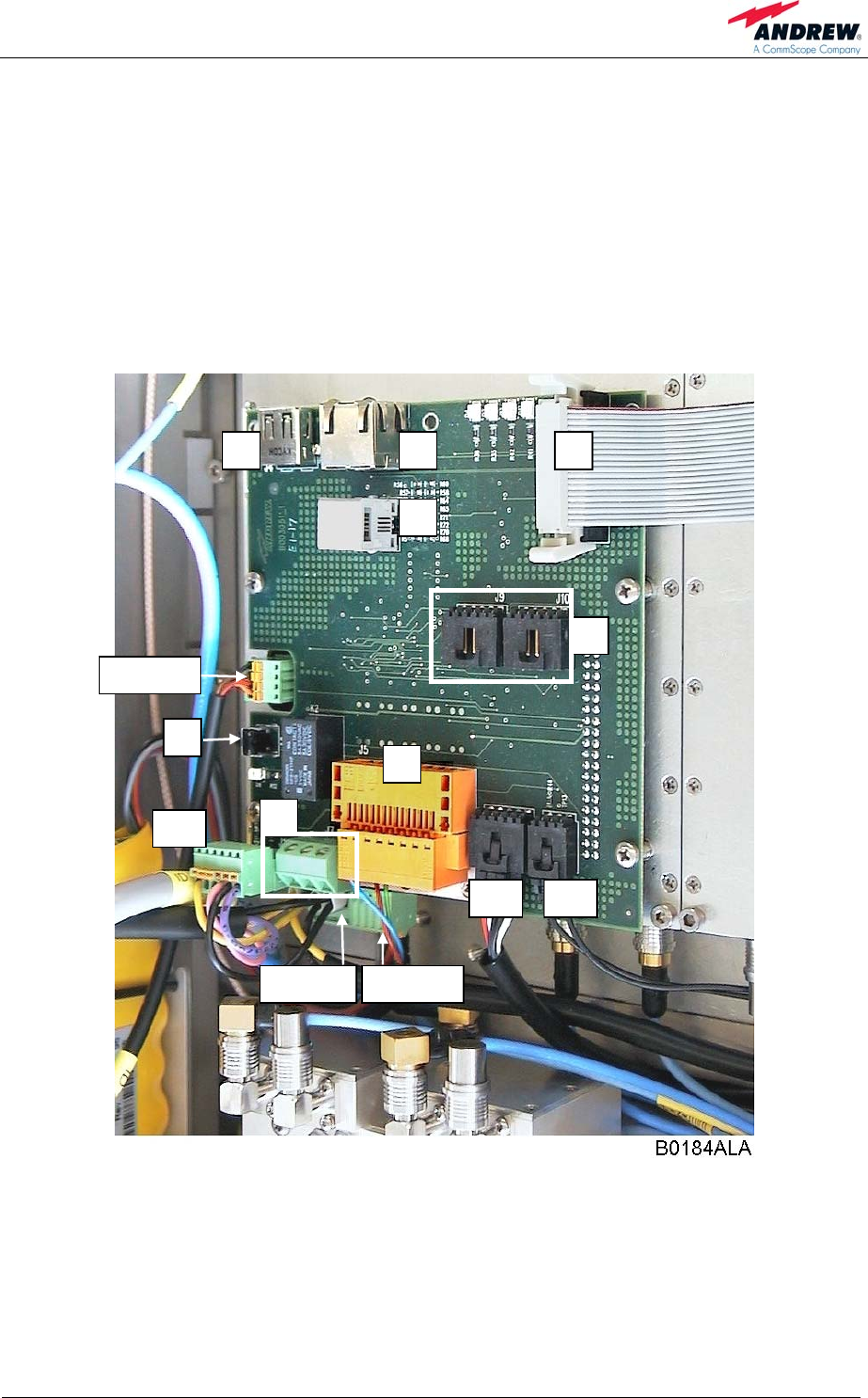
5 Functional Description
Page 49
5.2.11. External Alarm Controller - EAC-Board
5.2.11.1. Connectors on the EAC-Board - Description
The EAC circuit board is used for general purpose housekeeping functions of the
Node.
The EAC circuit board is the main connection point for the user. It has the external
alarm clamps, the connectors for local or modem connection, as well as a summary
alarm relay. The following figure shows an installed EAC-board.
1 2 3
4
figure 5-17 EAC-board, installed
5
6
7
8
9
10
DCM-
A
11
DCM-B DCM-C
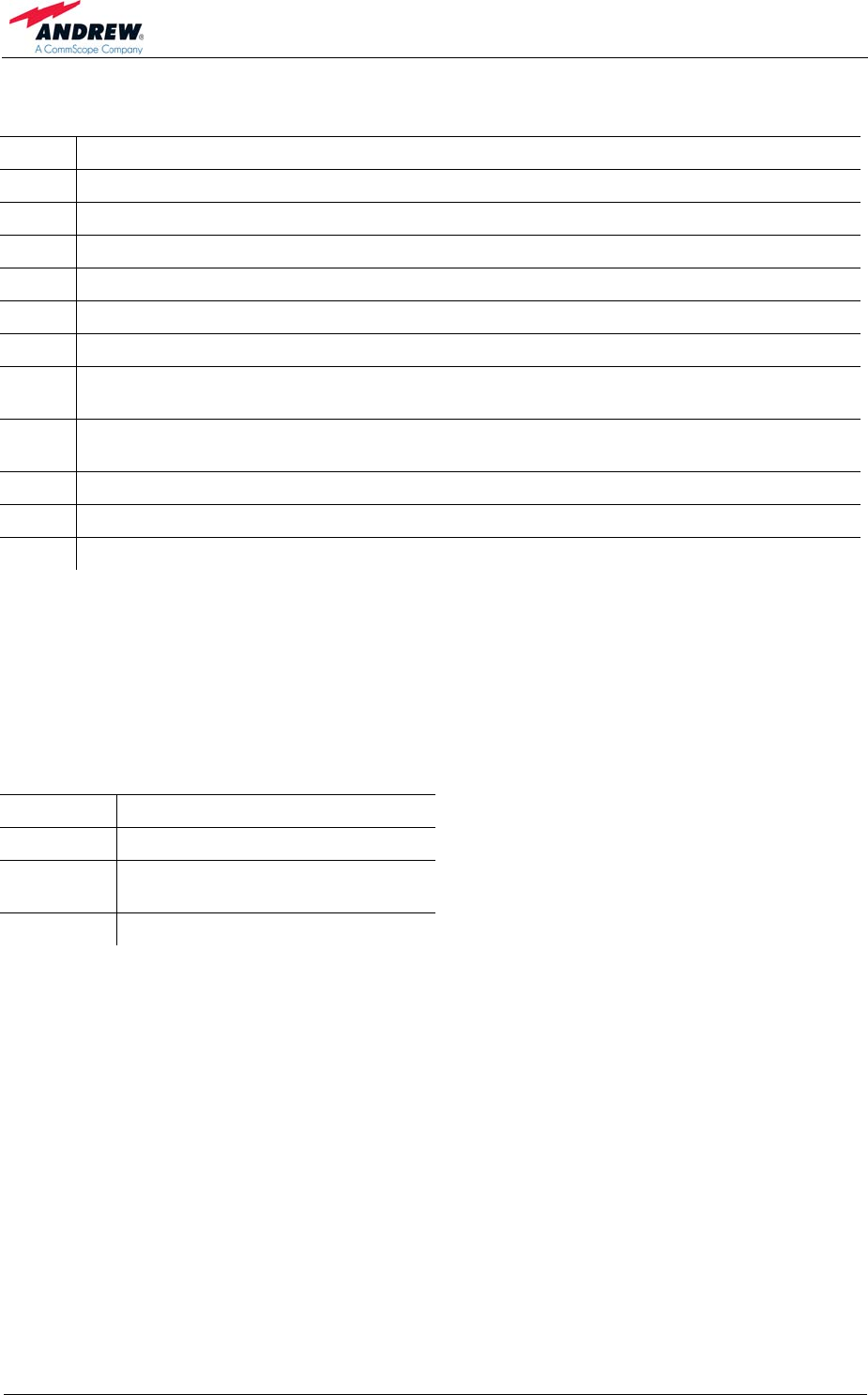
User’s Manual for Node M and Node C
Network Elements
Page 50 M0121A4A.doc
Connectors on the EAC-board
No Explanation
1 1, 2 USB connector for modem
2 1 Ethernet connector RJ45 for local and LAN web access
3 Internal DCM (DL) - DCM (UL) interface connection
4 1 Internal PSTN connector
5 Internal I2C (not used)
6 Battery disconnect button
7 1 External alarms, summary alarm LED & PSTN, see chapter 5.2.11.3
External Alarms
8 1 Summary alarm terminal; for pin assignment see chapter 5.2.11.4 Summary
Alarm
9 Internal PSU and I2C connection
10 Internal I2C (used for electronic door label memory board)
11 Door switch connector
1 Only these connectors are for general customer use. All others designated above are for
informative purposes, and required, only, e.g. for an upgrade or replacement of parts.
2 Only one modem can be used at the same time.
Connectors on the DCM DL module
See chapter 5.2.10 Digital Channel Module (DCM).
No Explanation
DCM-A Fan connector (Node x43)
DCM-B Vdc DL digital channel
module
DCM-C Battery backup connector
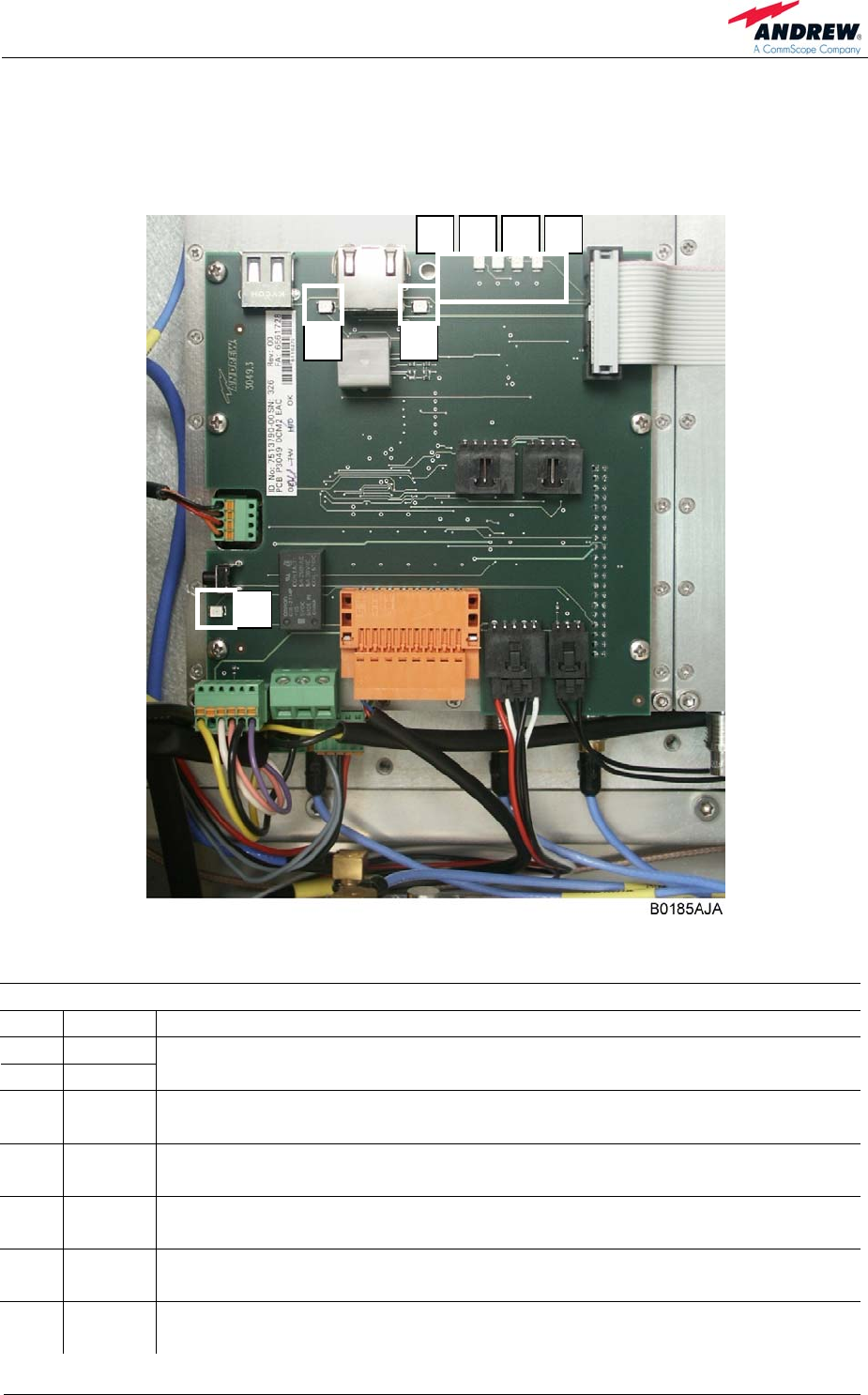
5 Functional Description
Page 51
5.2.11.2. LEDs - Description
Seven LEDs are included on the EAC-board. They are controlled via the I2C bus.
figure 5-18 Function of LEDs on the EAC-board
Colours and illumination functions
No Colour Explanation
1 Yellow
2 Green
Ethernet connector LEDs, see chapter 3.1 Setting up a Local / LAN
Connection from Laptop / PC
3 Green
DL PWR - illuminates when the DL Power is "Good" and the DL is
NOT in battery backup.
4 Green
UL PWR - illuminates when the software on the UL sets a bit in the
FPGA indicating power is "good".
5 Blue
USER1 - illuminates when software activates. The LED is controlled
by software through the I2C bus.
6 Red
ALARM - illuminates when a software defined alarm condition exists.
This LED is controlled via the I2C bus.
7 Yellow
BBU ACTIVE - when illuminated the DL-DCM is in battery backup
mode.
2
3 4 5 6
7
1
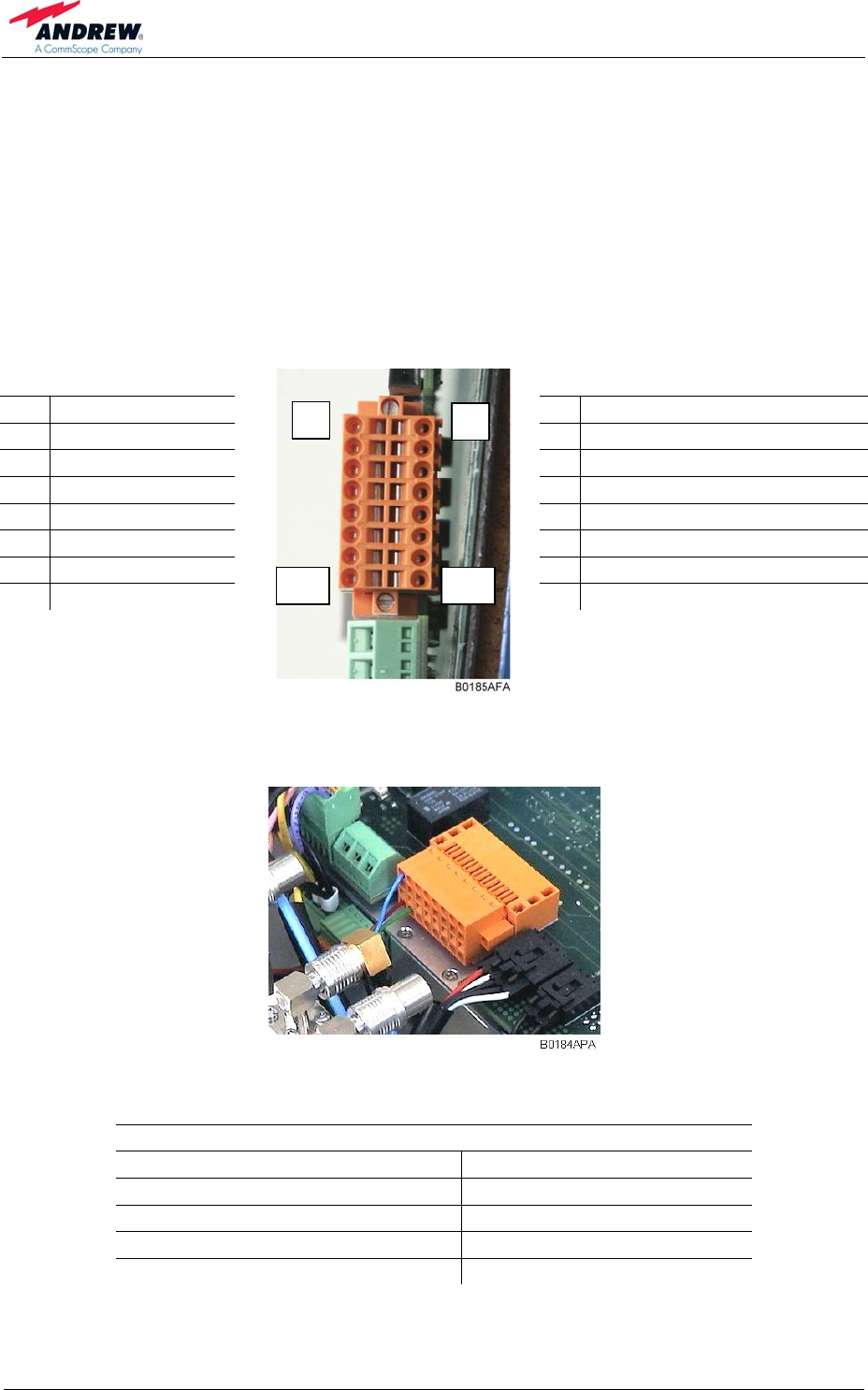
User’s Manual for Node M and Node C
Network Elements
Page 52 M0121A4A.doc
5.2.11.3. External Alarms
The external alarms are used to monitor the status of one or more external devices
via the Node M/C. A UPS or entry alarm is among the items that might be connected
to the contact relay and monitored via the Node M/C. The cage clamp connectors are
located on the EAC-board.
Observe that the cross-sectional area of the wires to be connected must be in the
range from 0.5 - 1.0 mm2. Do not use wire-end sleeves (wire cable ends).
2 n.c. 1 n.c.
4 GROUND 3 EXT_ALARM_3
6 GROUND 5 EXT_ALARM_2
8 GROUND 7 EXT_ALARM_1
10 PSTN_1_EXTERNAL 9 PSTN_1_INTERNAL
12 PSTN_2_EXTERNAL 11 PSTN_2_INTERNAL
14 GROUND 13 SUMMARY ALARM, LED GREEN
16 GROUND 15 SUMMARY ALARM, LED RED
figure 5-19 Pin assignment
1
2
16 15
figure 5-20 External alarm clamps, installed
External Alarms 1 to 3
Input voltage range 5 Vdc
Recommended input line Potential free
Nominal sink current to ground 15 mA
Active level High or low set via software
Connectors Cage clamps
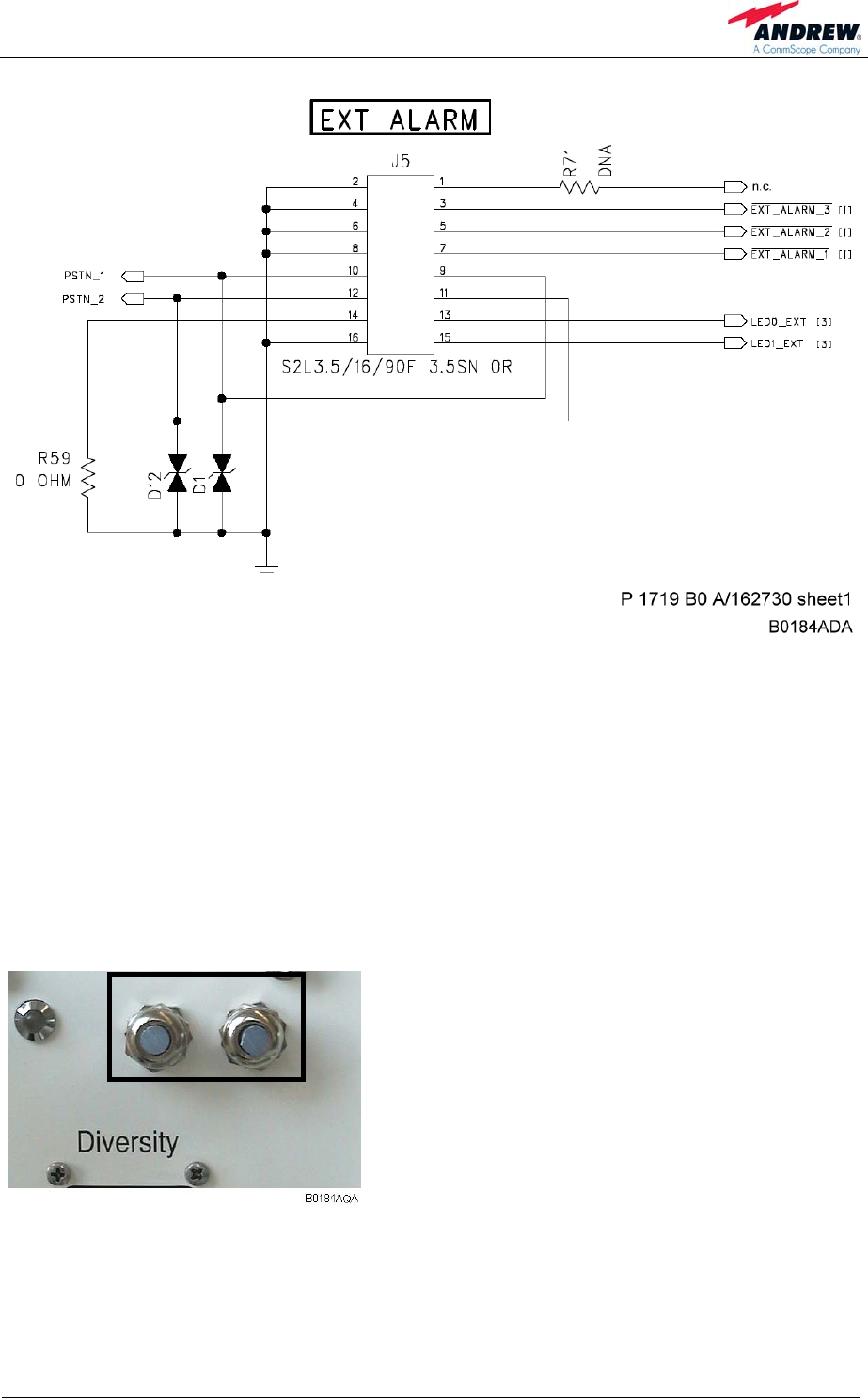
5 Functional Description
Page 53
figure 5-21 Configuration of external alarm clamps
All external alarms are defaulted to high (5 VDC) without connection. This setting
may be changed on the external alarm page to active high or active low. The severity
levels of the external alarms may be set via the web page. More information about
the external alarm settings is available in the web page and online-help.
Make sure that external alarms which are not required are set to active low or disable
them; otherwise the status will always show an alarm.
The names for each external alarm are user-definable on the external alarm page;
renaming them to indicate the use of these alarms is recommendable.
There are two external cable glands (PG7) at
the bottom of the Node. They may be used to
connect the external devices. Please note that
connecting the external devices by a wrong
type of cable may result in a loss of the water-
proofness. The recommended cable diameter is
4 - 6 mm.
figure 5-22 External cable glands
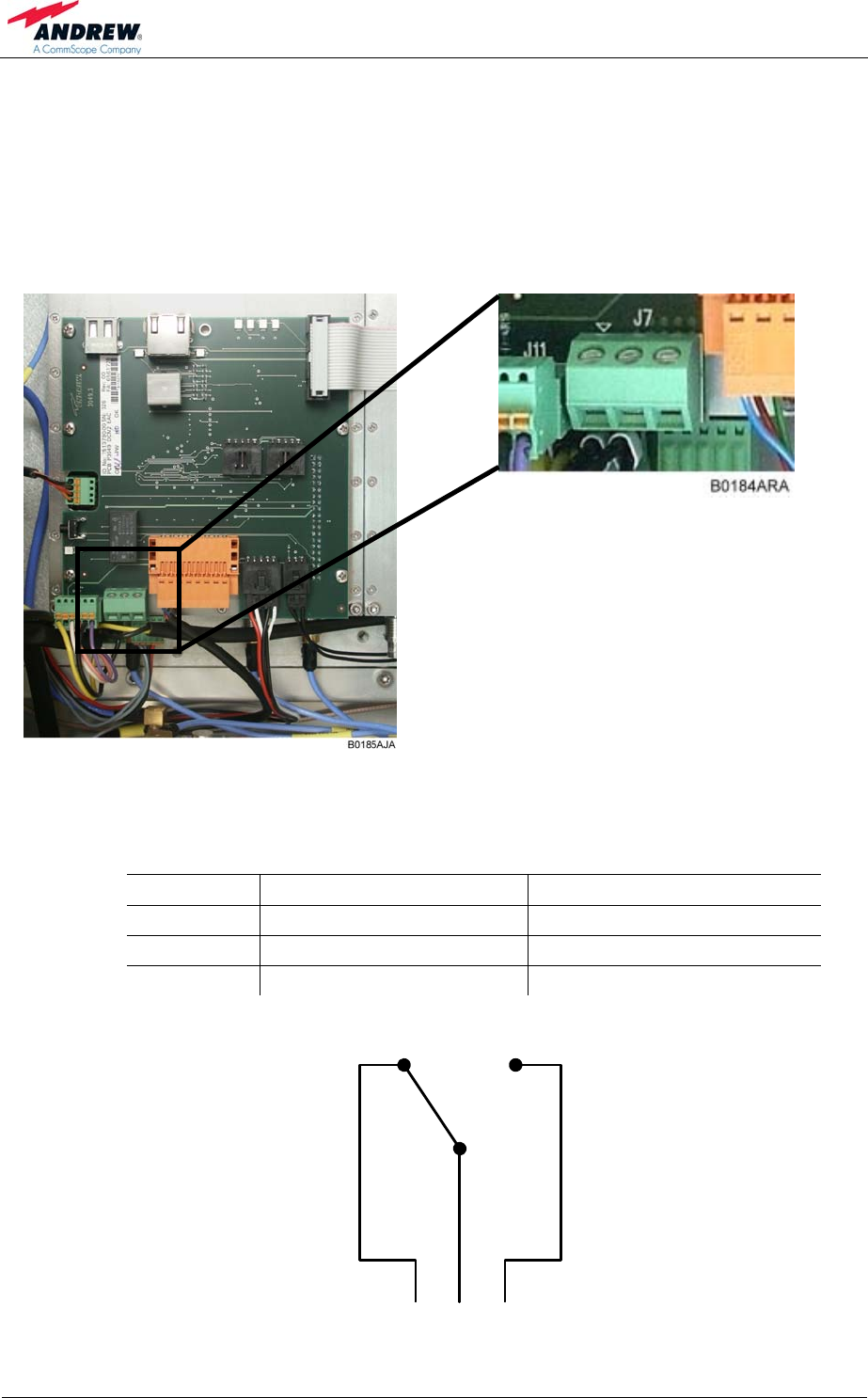
User’s Manual for Node M and Node C
Network Elements
Page 54 M0121A4A.doc
5.2.11.4. Summary Alarm
The summary alarm is a DC potential-free contact relay.
Observe that the cross-sectional area of the wires to be connected must be in the
range from 0.14 - 1.5 mm2.
Pin No: 1 2 3
figure 5-23 Summary alarm relay
The following table indicates the three-connector pin out.
Pin No Contact Maximum Resistive Load
1 Open in alarm condition Max 1 A @ 50 Vdc
2 Common Max 2 A @ 30 Vdc
3 Closed in alarm condition Max 1 A @ 230 Vac
table 5-1 Pin assignment of relay contacts
Pin 3 Pin 2 Pin 1
B0185AHA
figure 5-24 Relay contacts, alarm condition
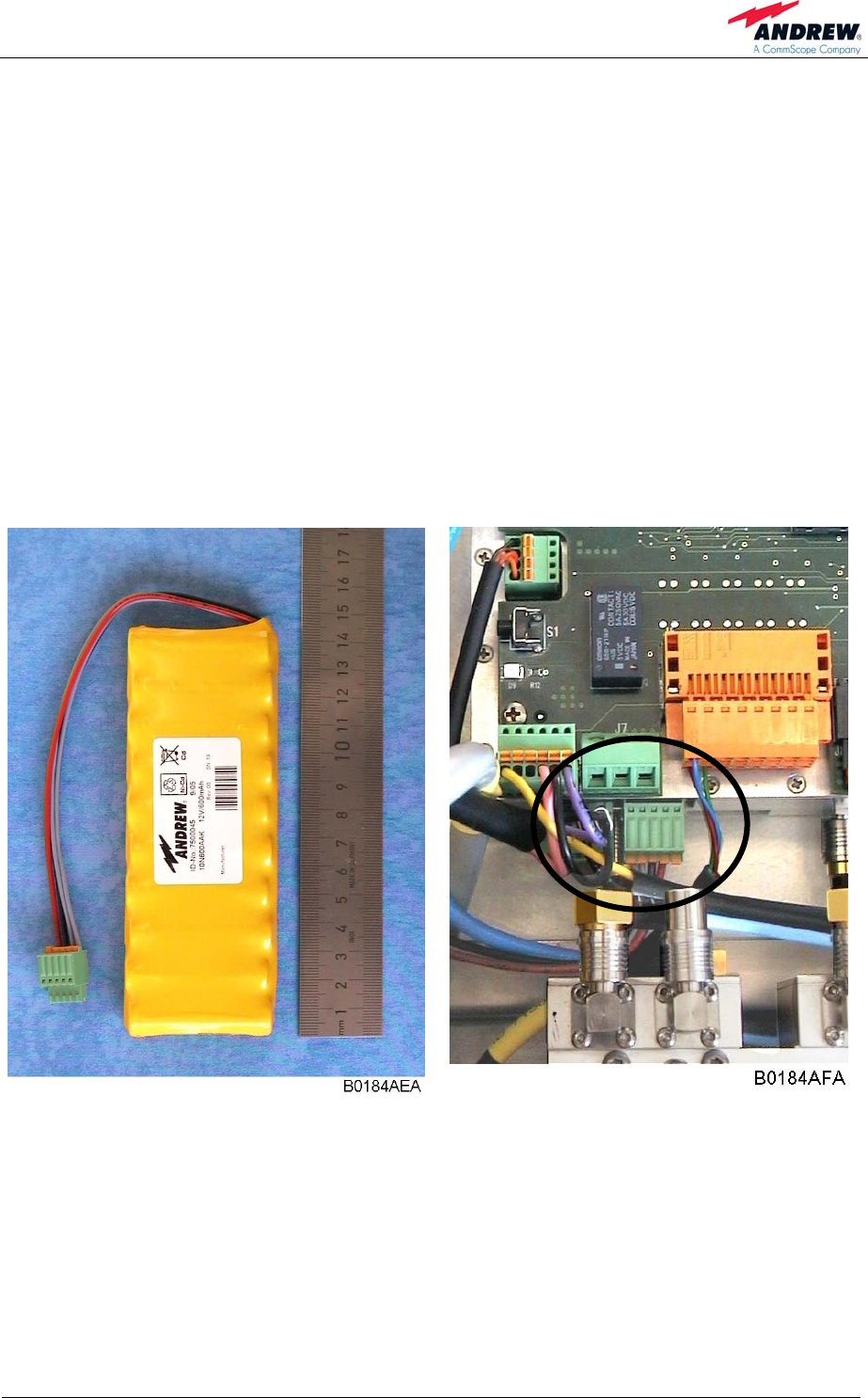
5 Functional Description
Page 55
5.2.12. Battery Pack - Battery On/Off
In case power fails, a battery backup system for controller and modem has been
implemented. This provides enough power for the controller that is integrated into the
DCM and the modem to operate for a limited period of time (battery backup time).
Within this time, the Node M/C will initiate a call to the OMC and alert the operator
that power has been lost. All other functions will cease to work in case of power
failure.
The battery pack is protected from deep discharge. When performing preventive
maintenance, make sure that all circuits are voltage free by disconnecting the battery
cable from the DCM. In case of a power cycle, it is sufficient to press the “Battery
disconnect button” on the EAC-board to interrupt the voltage supply. After mains is
connected again, the battery will be charged and the battery backup function will be
available again.
figure 5-25 Battery pack, exemplary figure 5-26 Battery pack installed and its
connection to DCM
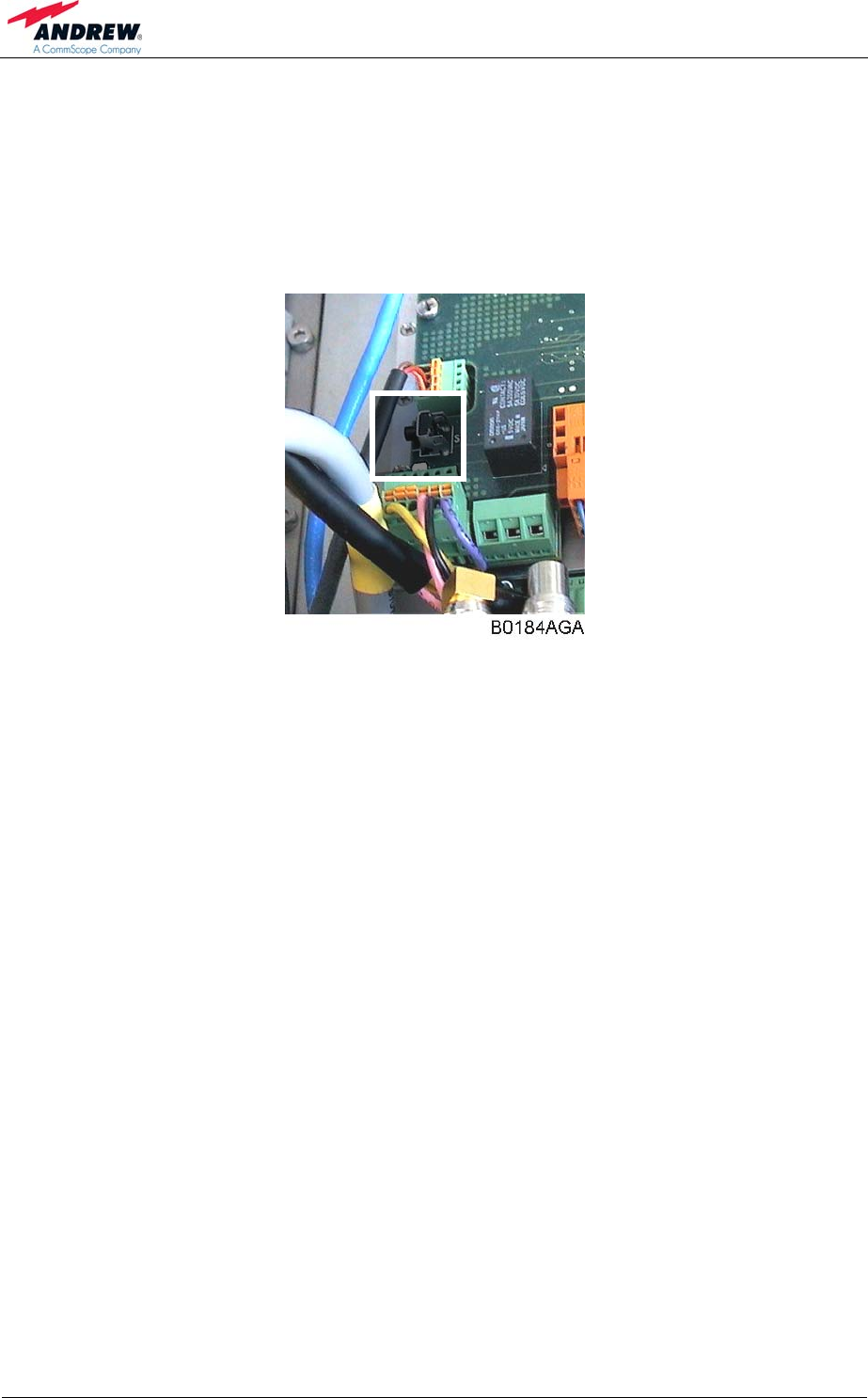
User’s Manual for Node M and Node C
Network Elements
Page 56 M0121A4A.doc
Battery On/Off
A pushbutton on the EAC-board is implemented to disconnect the battery pack from
the controller. This forces a hard reset of the system.
Once disconnected, the power to the controller will not be restored until the +28V
supply is again operational.
Battery
disconnect
button
figure 5-27 Position of the battery disconnect button
on the EAC-board
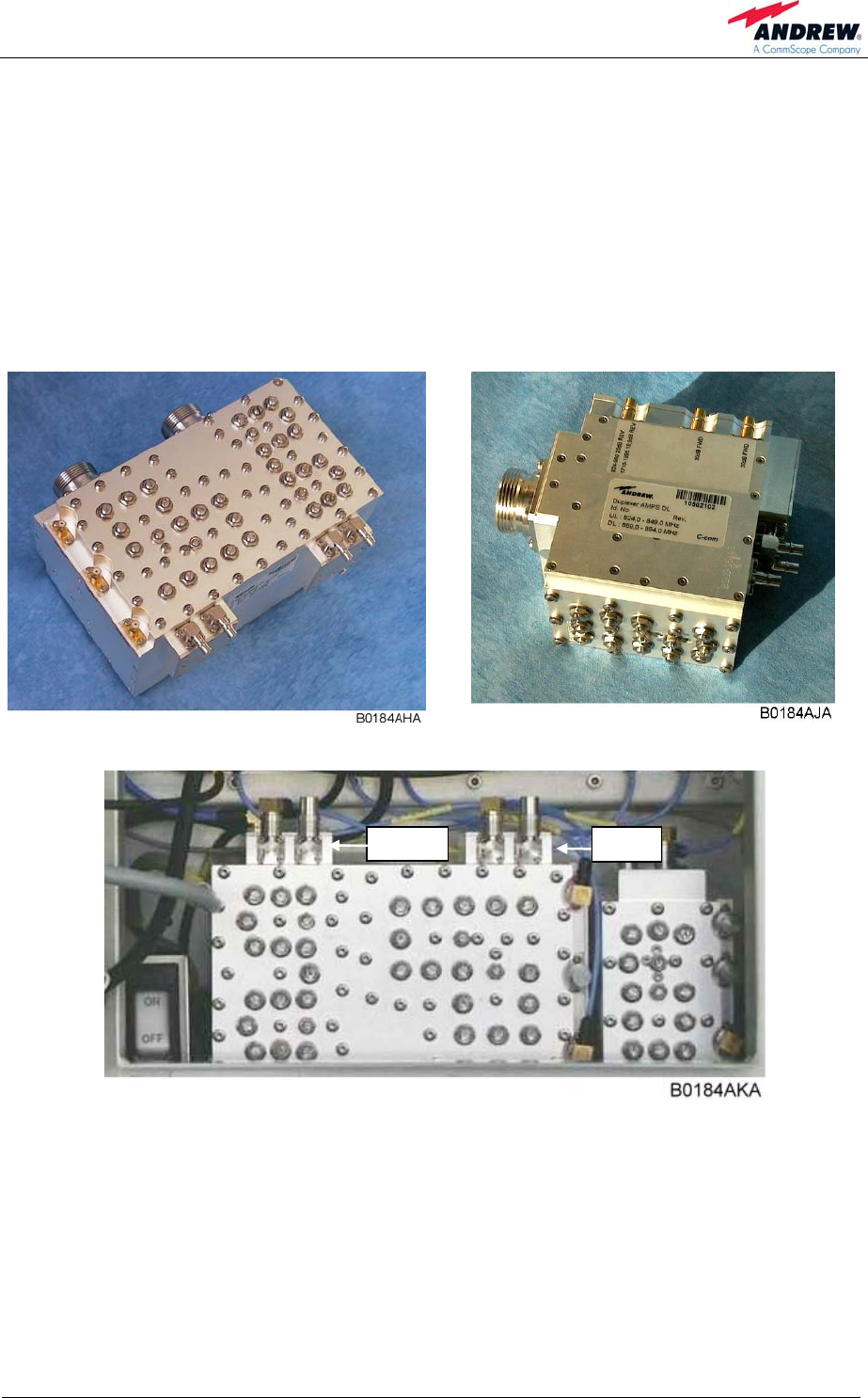
5 Functional Description
Page 57
5.2.13. UL and DL Duplexer
The duplexer is used to isolate the uplink from the downlink, i.e. to separate the
transmitting path from the receiving path. The pass band of the duplexer is the full
band (UMTS/CDMA). This allows the same Node M/C to be used regardless of its
operator’s frequency plan.
The UL and DL duplexers have multiple outputs, including the primary and extension
path, plus forward and reverse probes used for auto setup, VSWR, and RSSI
functions.
figure 5-28 Duplexer, UL IN figure 5-29 Duplexer, DL IN
figure 5-30 Duplexers installed
LNA
LN
A
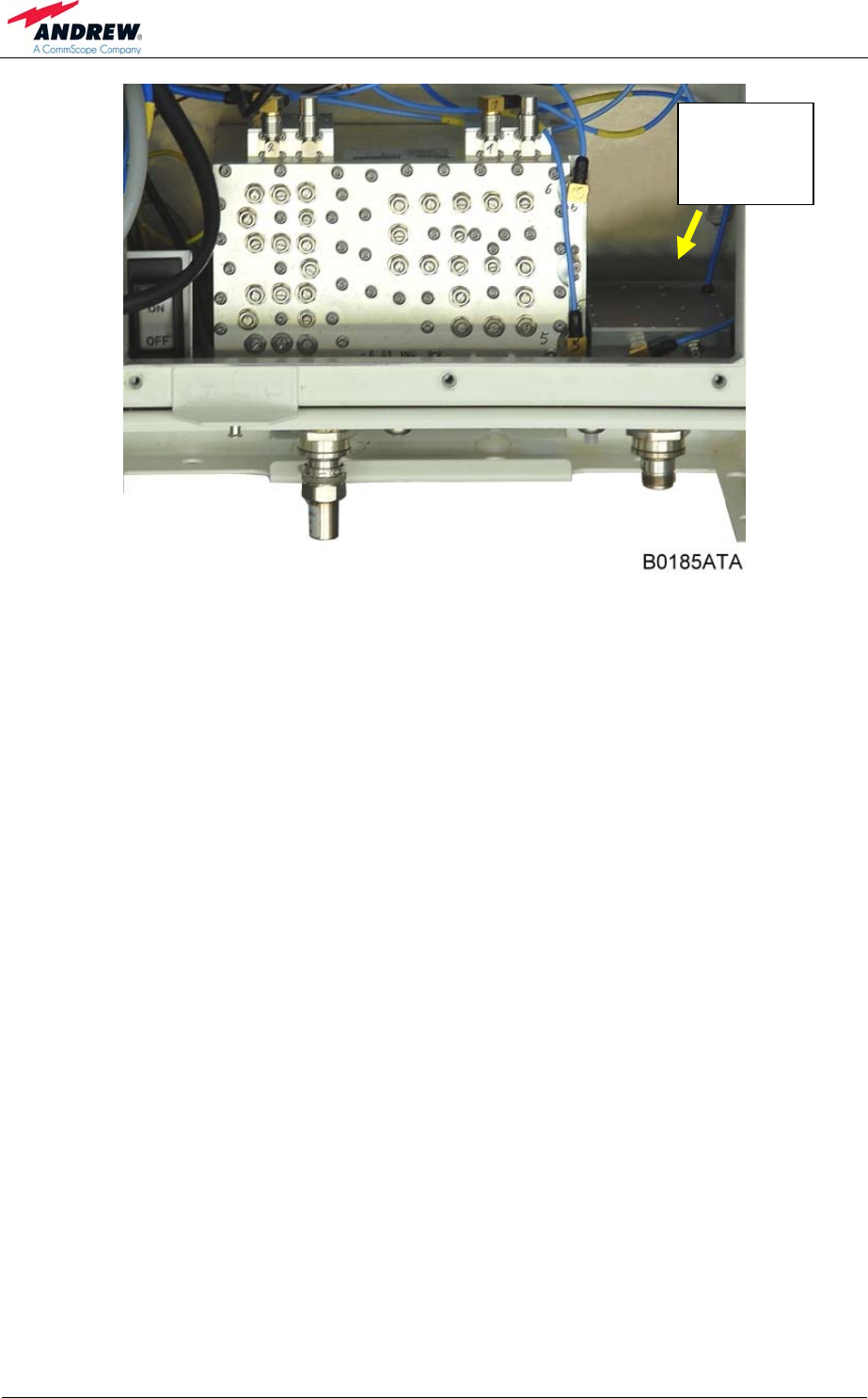
User’s Manual for Node M and Node C
Network Elements
Page 58 M0121A4A.doc
Ceramic
duplexer
DL IN
figure 5-31 Duplexers installed, ceramic duplexer DL IN
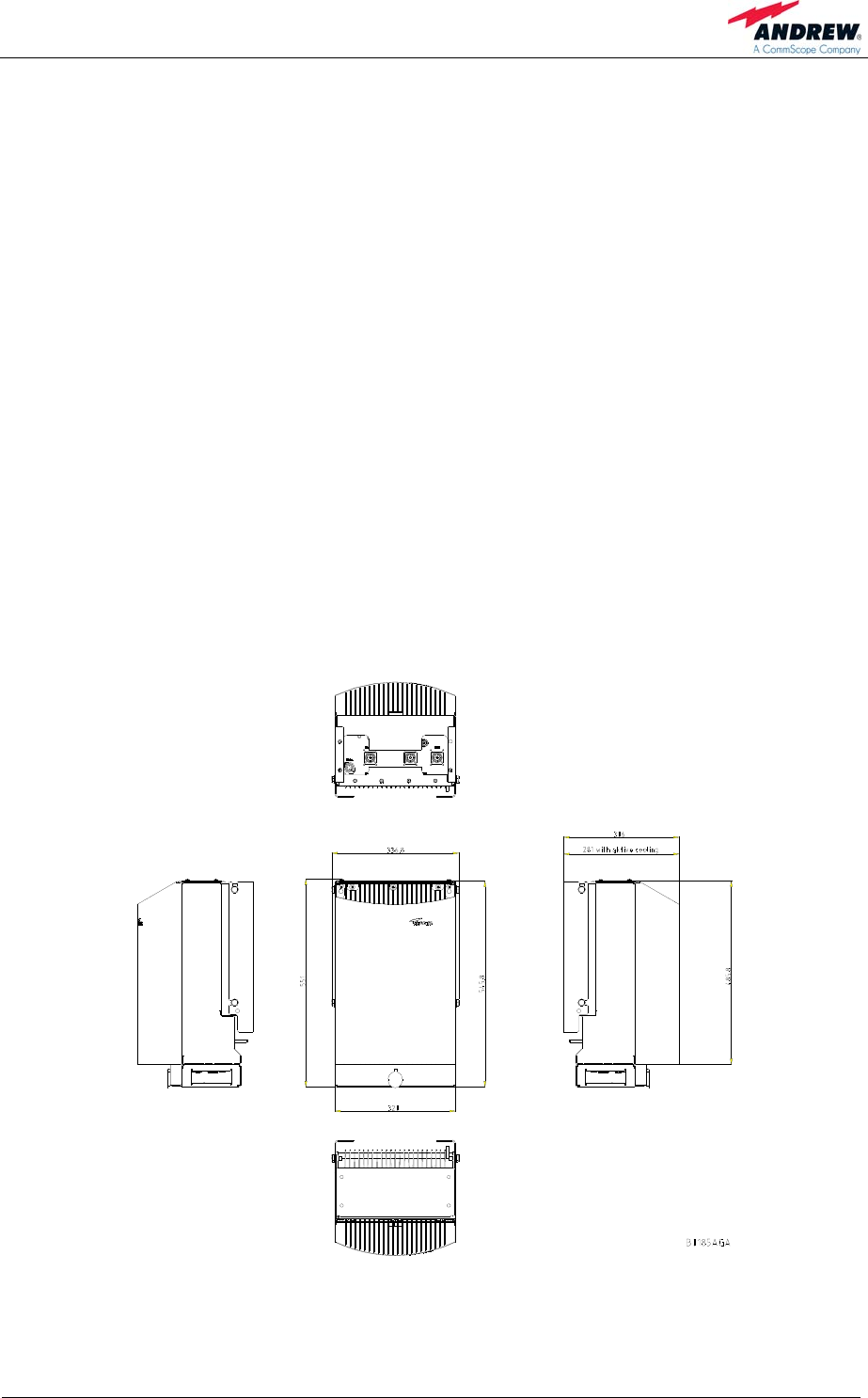
6 Maintenance and Replacement
Page 59
6. MAINTENANCE AND REPLACEMENT
Read the health and safety warnings in chapter 1.2 Health and Safety Warnings.
) Note: Node M and Node C do not require any preventative maintenance
measures.
) Note: In case of a defect replace the entire repeater. When sending back
the unit, use an appropriate packaging. We strongly recommend
using the original packaging!
7. ILLUSTRATIONS
7.1. CABINET DRAWING
The cabinet measures of the Nodes described in this manual are nearly identical.
The following figure of a cabinet drawing exemplifies the proportions of Node M and
Node C.
figure 7-1 Cabinet of a Node M, respective Node C, exemplary
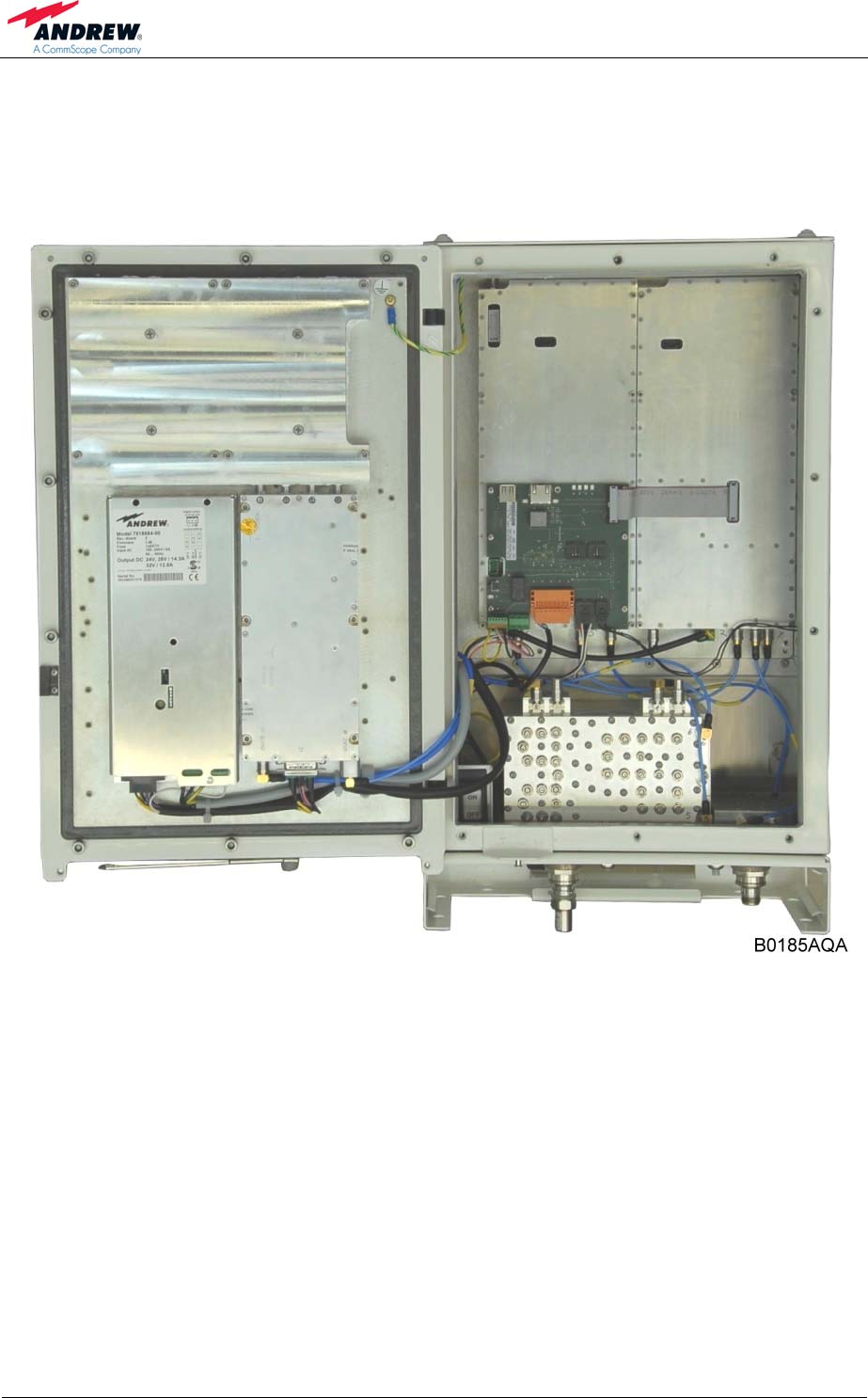
User’s Manual for Node M and Node C
Network Elements
Page 60 M0121A4A.doc
7.2. LAYOUT OF THE NODE M/C 843
The following figure is exemplifying the layout of a Node M/C 843.
figure 7-2 Layout of the Node M/C 843, exemplary

8 Index
Page 61
8. INDEX
A
Abbreviations 7
AC Breaker - Mains Power 32
Address of Andrew Wireless Systems GmbH 13
Alarm Forwarding 41
Alarm LEDs - Description 51
Alarms (External) 52
Amplifier (Feed-Forward) 42
Andrew Solutions 11
B
Battery - On/Off 56
Battery Disconnect Button 56
Battery Pack 55
C
Cabinet - Opening 34
Cabinet Drawing - Node M/C 59
CDMA - Standard Feature 39
Connection from Laptop or PC 19
Connections
Antenna 33
Power 31
Connectors on EAC-Board 49
Contact Addresses 12
Customer Support Addresses 12
D
DCM 48
Declaration of Conformity 11
Design 37
Digital Channel Module 48
Digital ICE 40
Diversity 33, 48
Duplexer 57
E
EAC-Board 49
Ethernet Connector 19
External Alarm Controller 49
External Alarms 52
External Cable Glands 53
F
Feed-Forward Amplifier 42
Filters Node C - Standard Feature 39
Filters Node M - Standard Feature 39
G
Grounding 30
H
Health and Safety Warnings 9
I
Installation
Electrical 29
Mechanical 23
L
LAN Connection 20
Layout of Node M/C 843 60
LNA 57
Local Connection 19
Low Noise Amplifier Look Up LNA
M
Mains Power
AC Breaker 32
Switch 35
Maintenance 59
Modem
General 45
GSM 45
MC35 45
MC55/56 45
MC75 45
MTCBA-C-N9 (CDMA) 46
Raven C3211 45
Raven XT 46
Redwing (CDMA) 45
Mounting
Brackets 27
General 23
Hexagon Head Screws M10 25, 27
Pole 26
Wall 24
P
Power Supply Unit 44
R
Relay Contacts 54
Remote Connection 21
Replacement 59
RF Block Diagram 37
RF Path 38
RSSI 41
S
SMS Alarm Forwarding 41
Summary Alarm - Pin Assignment 54
U
UMTS - Standard Feature 39
V
VSWR 40
